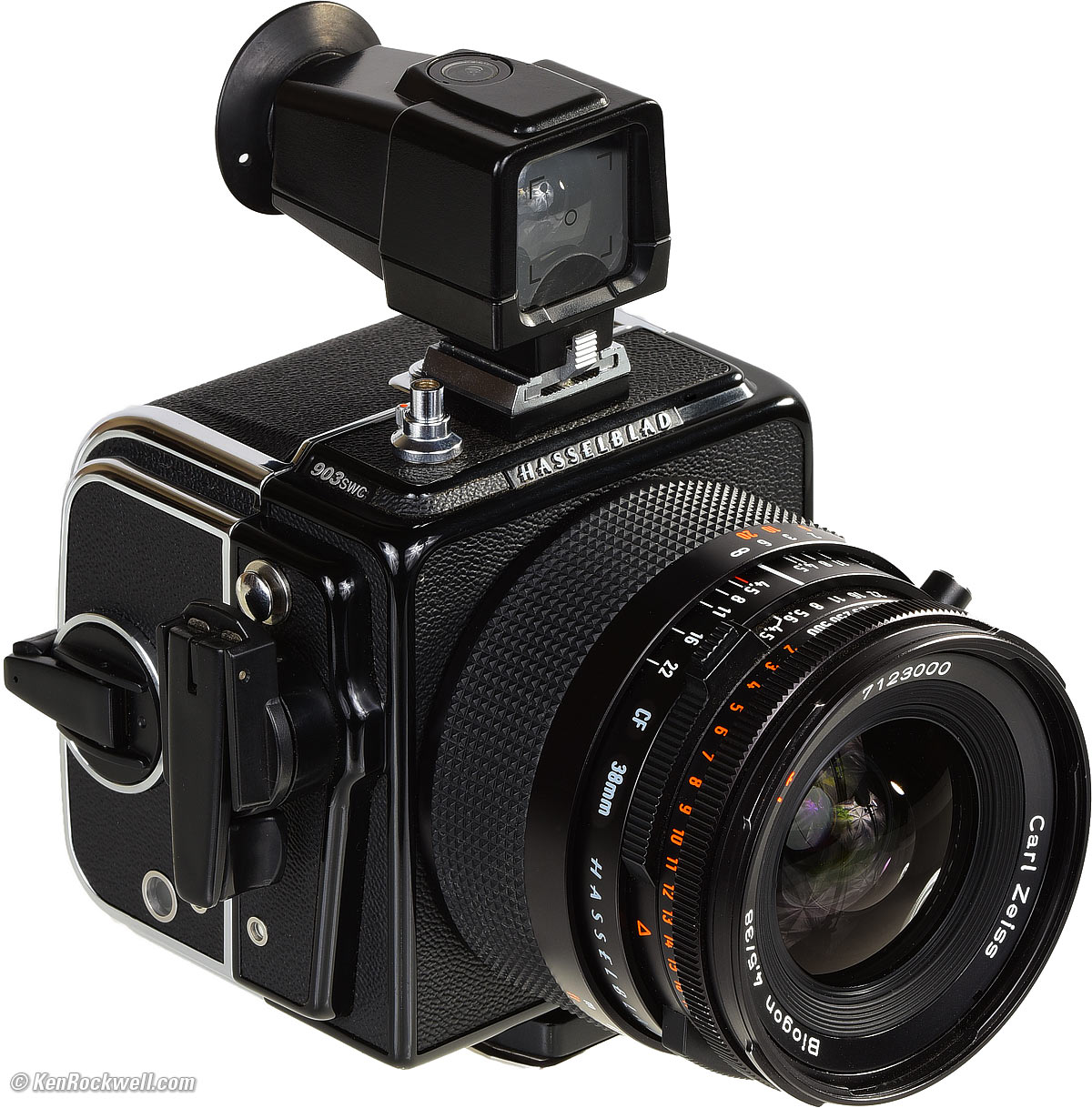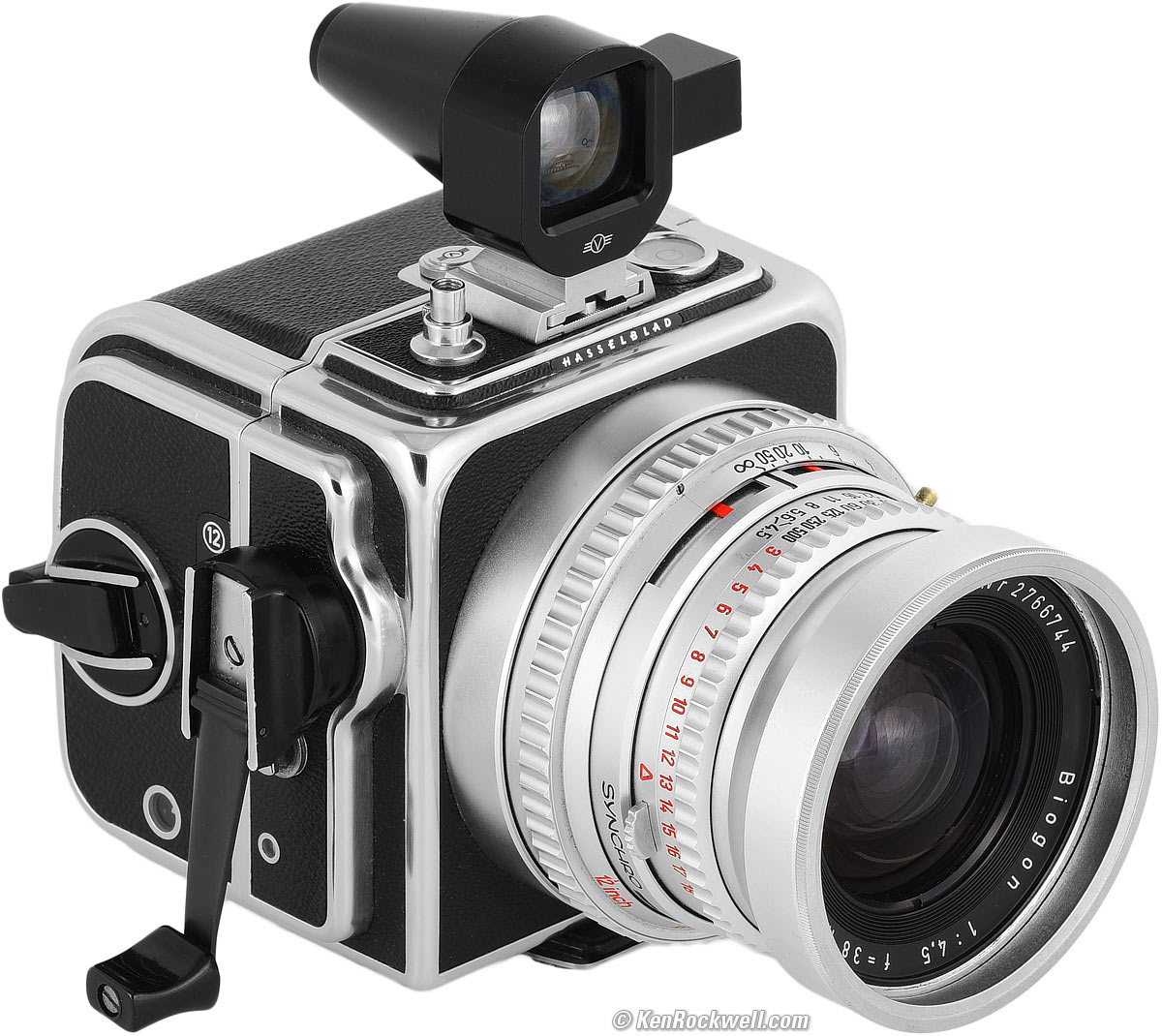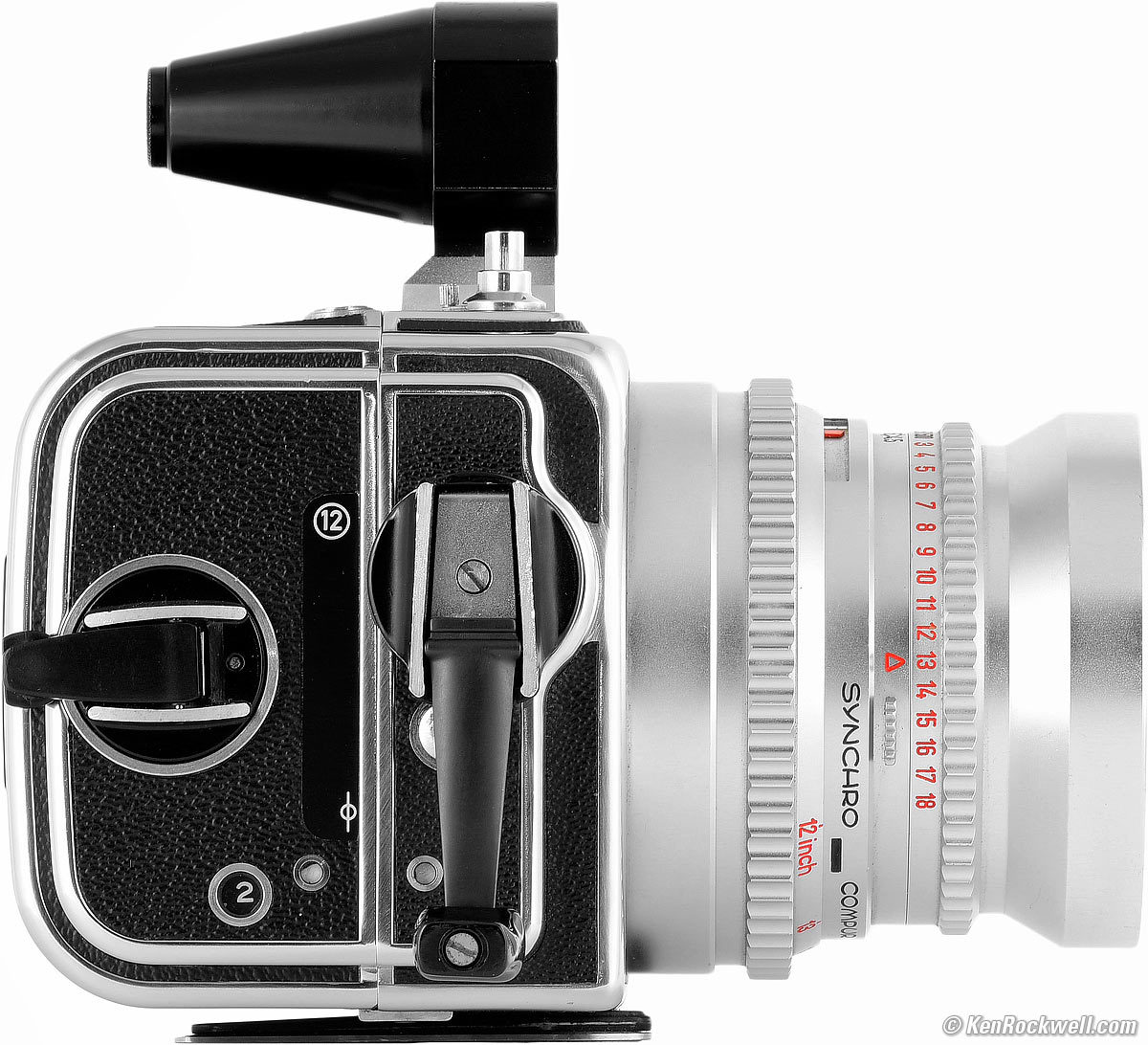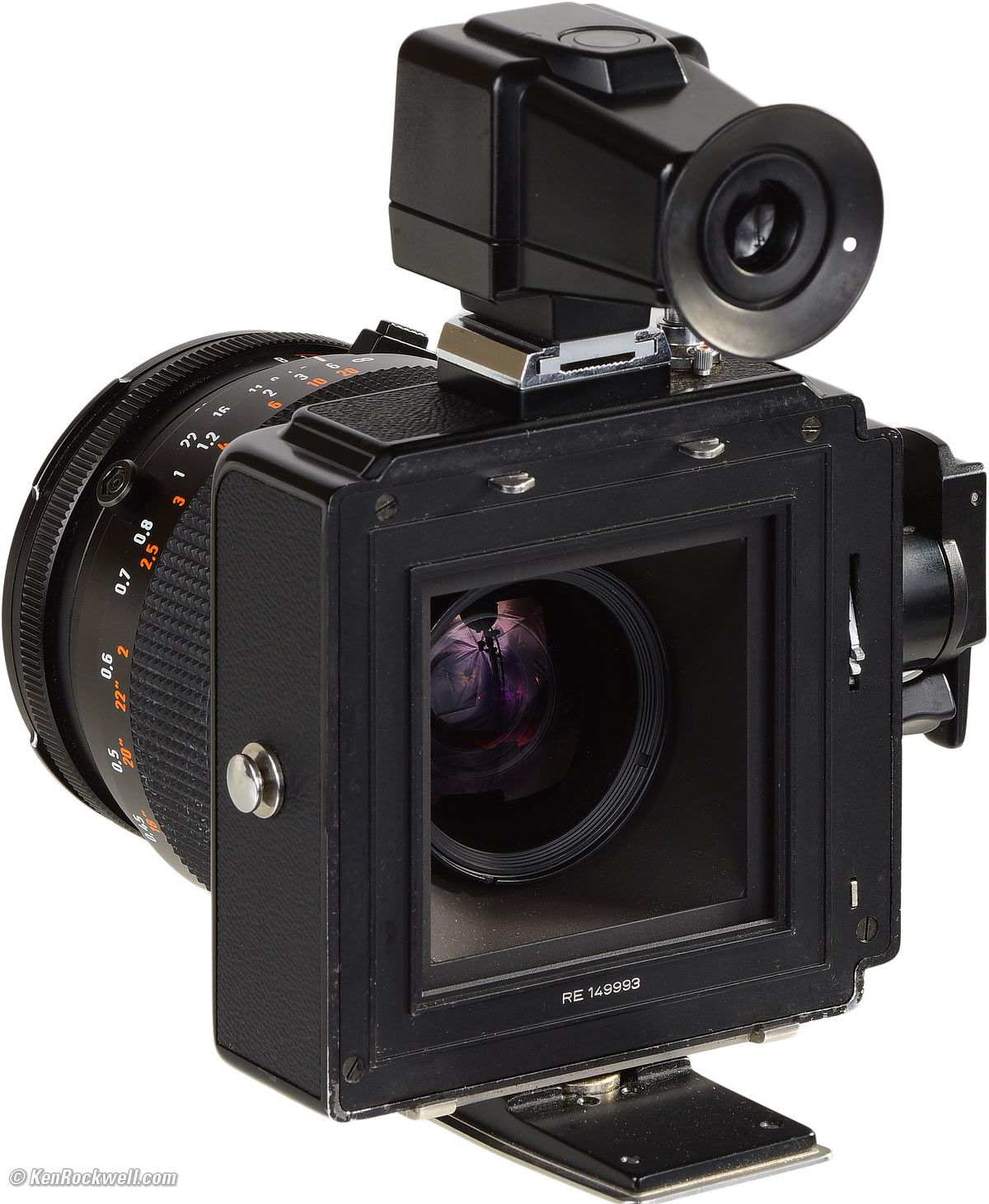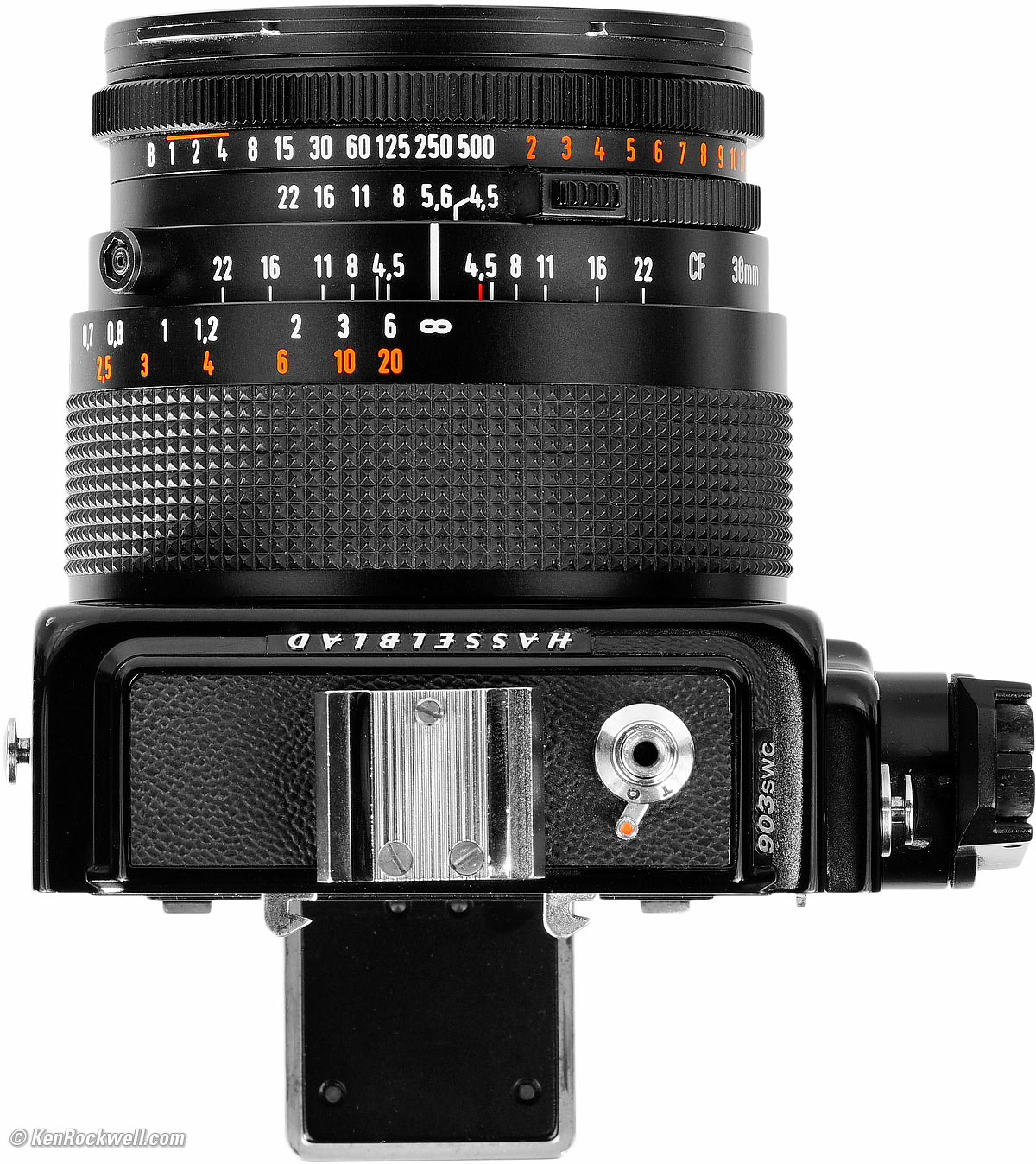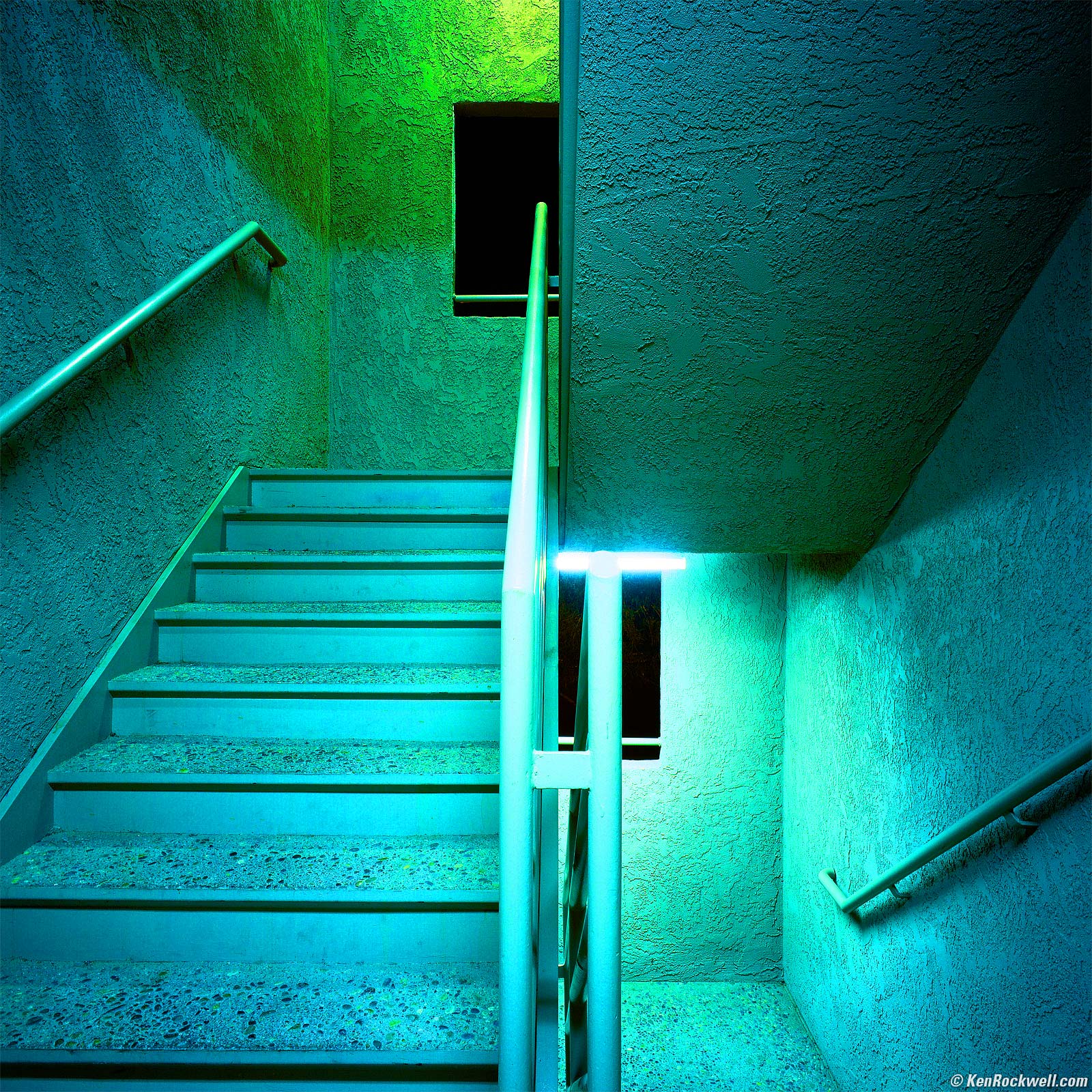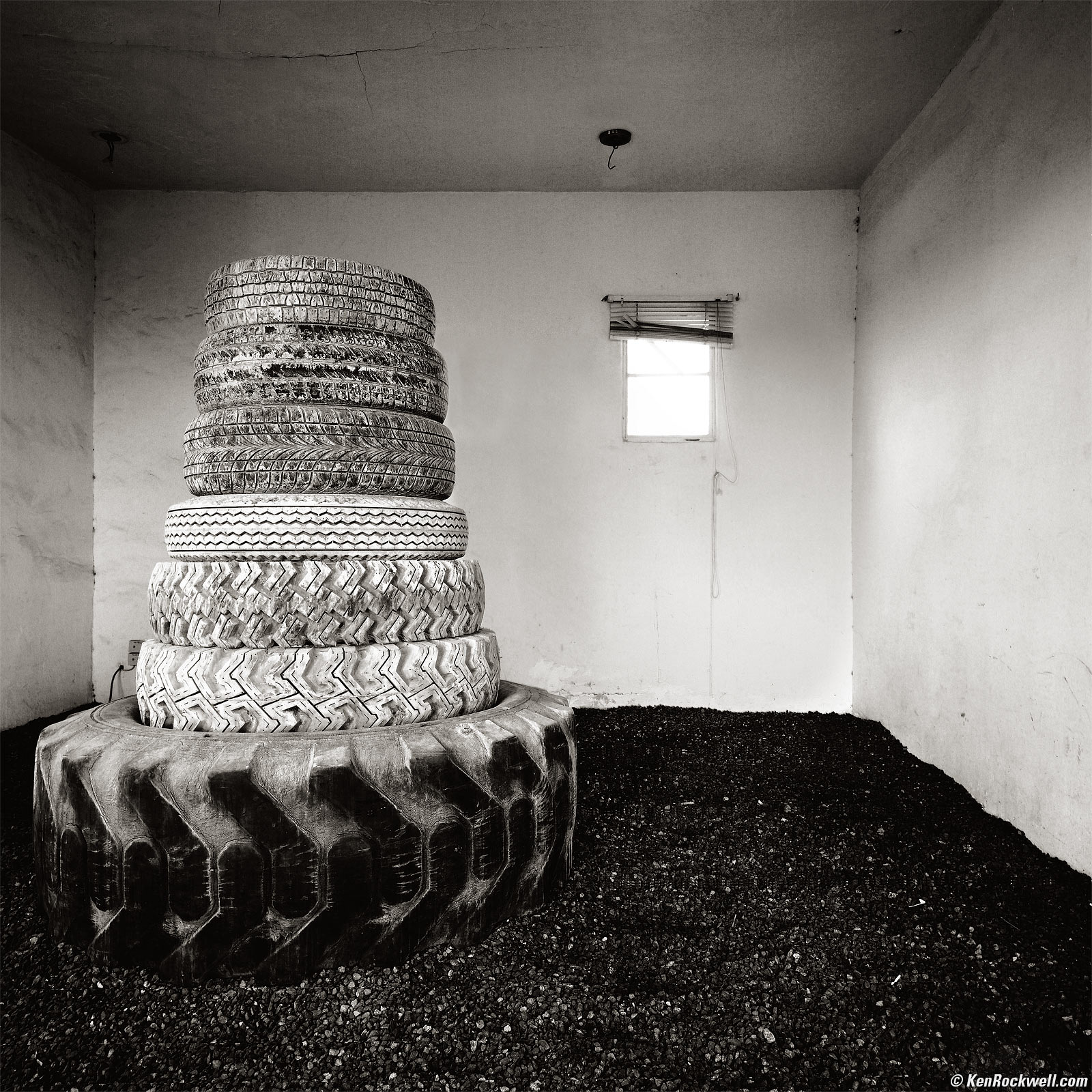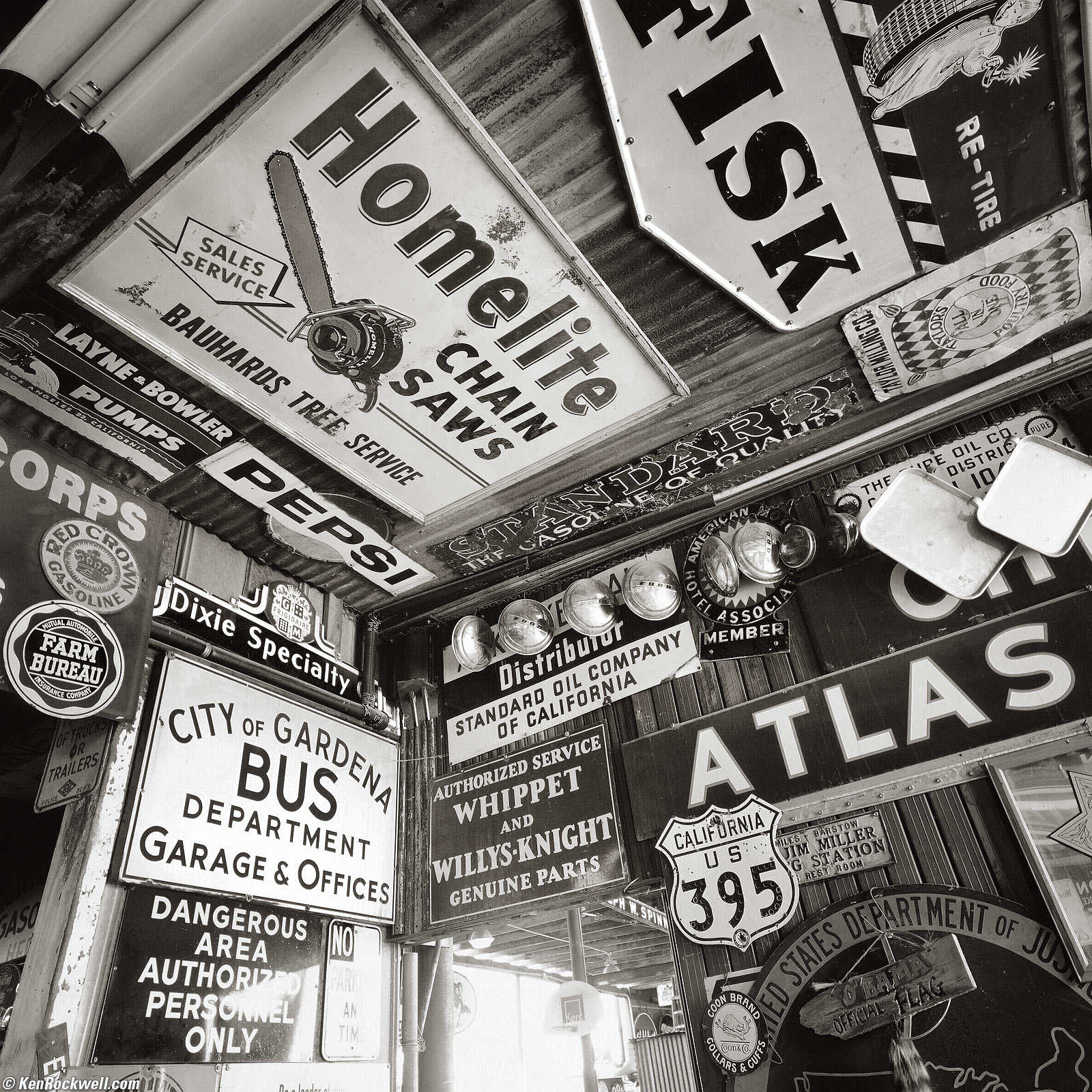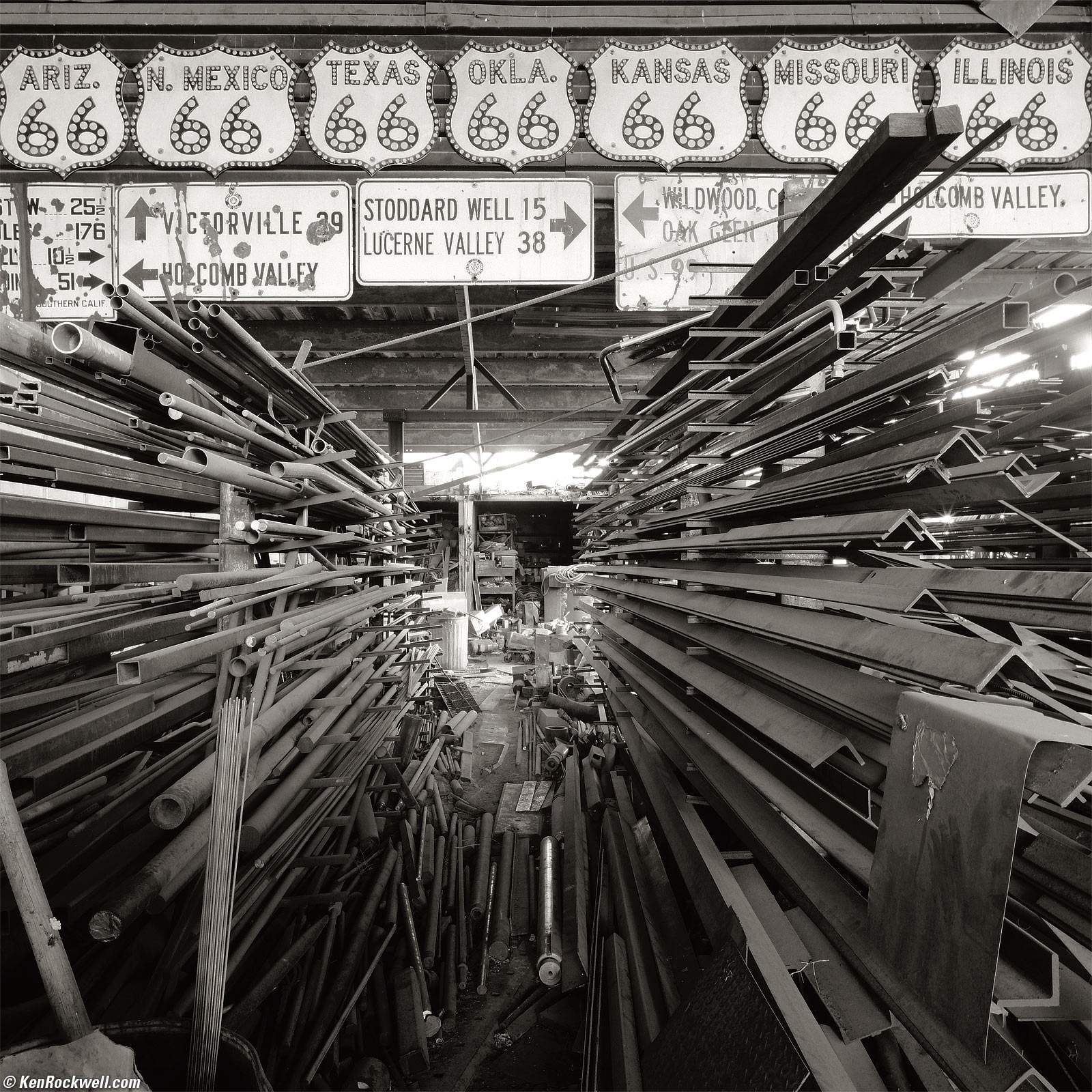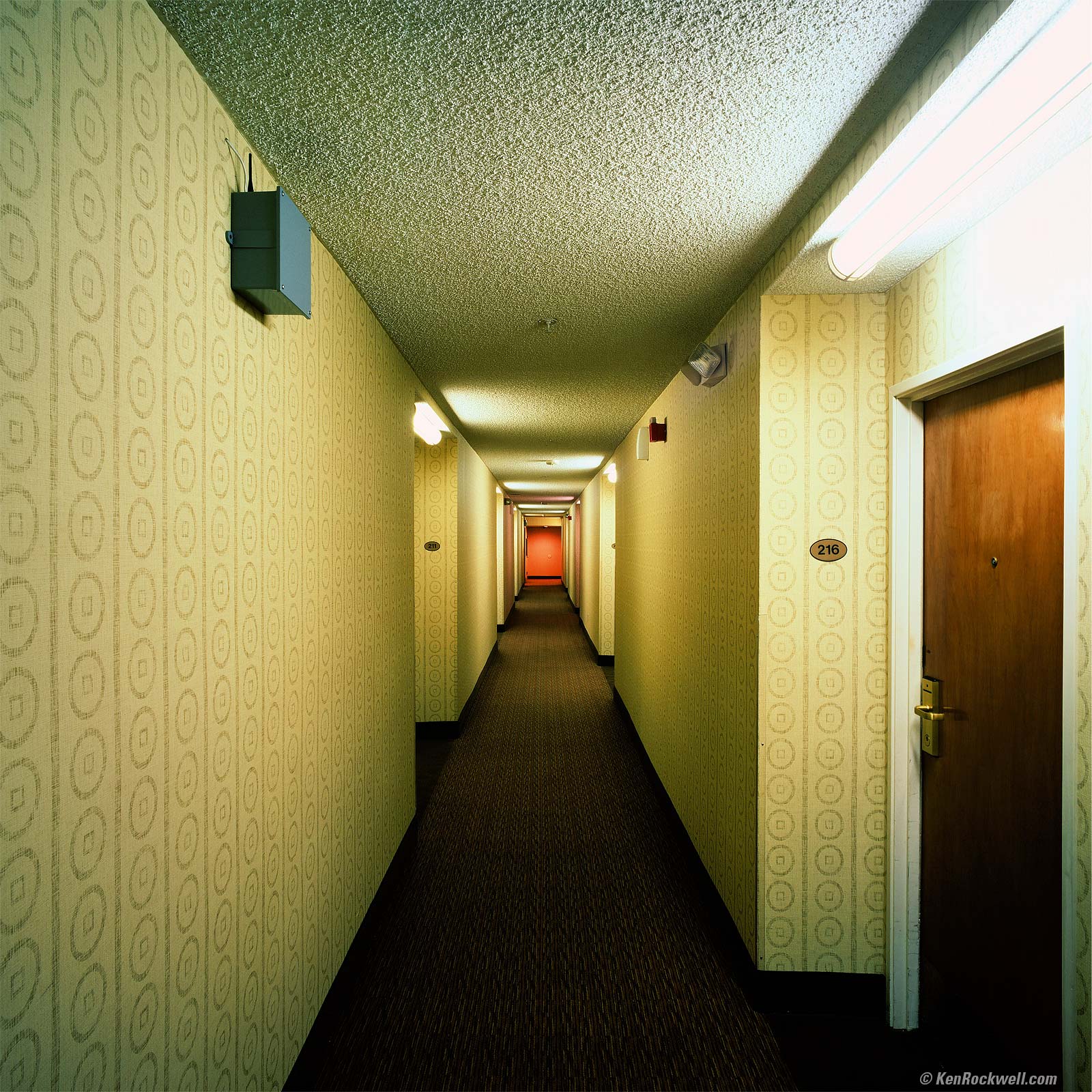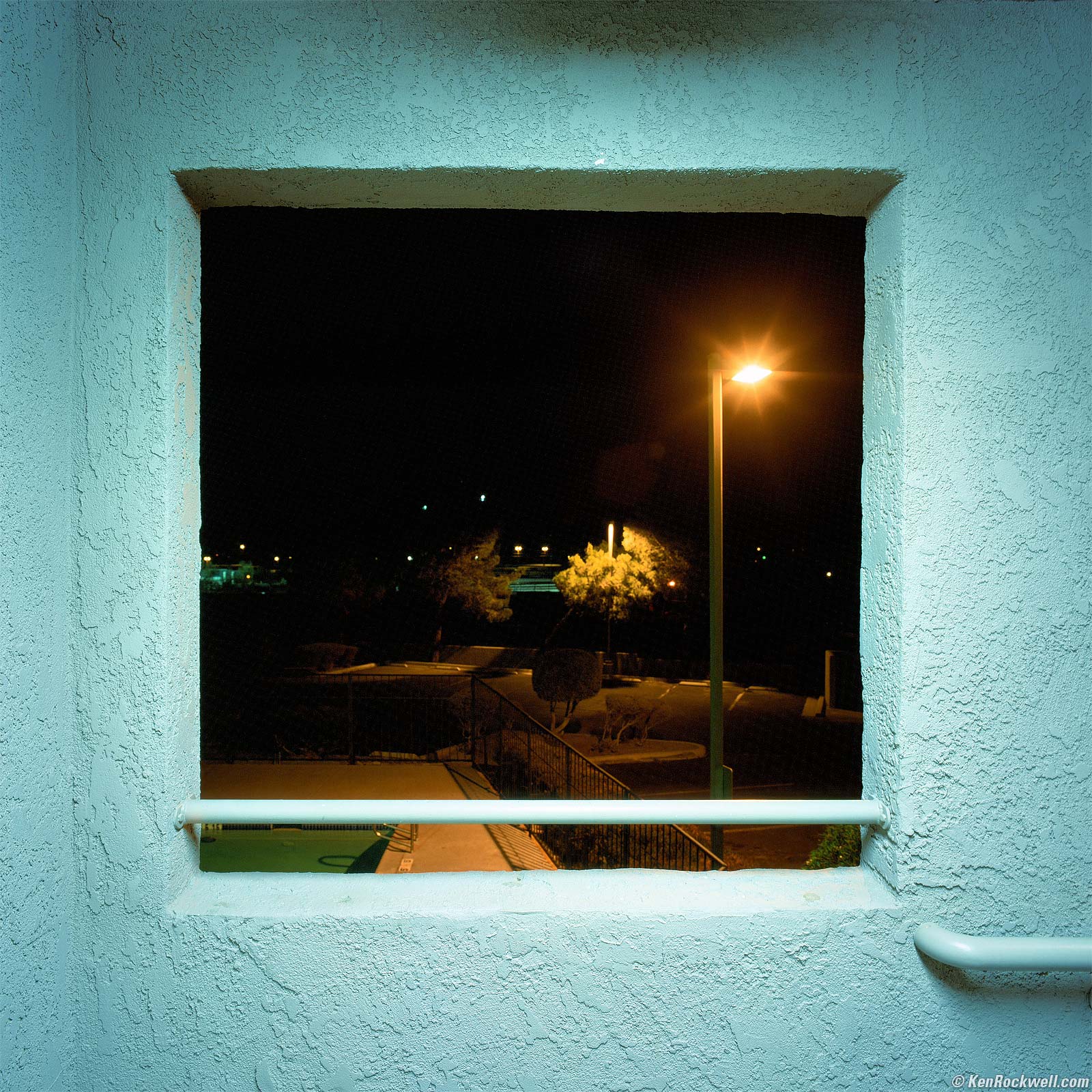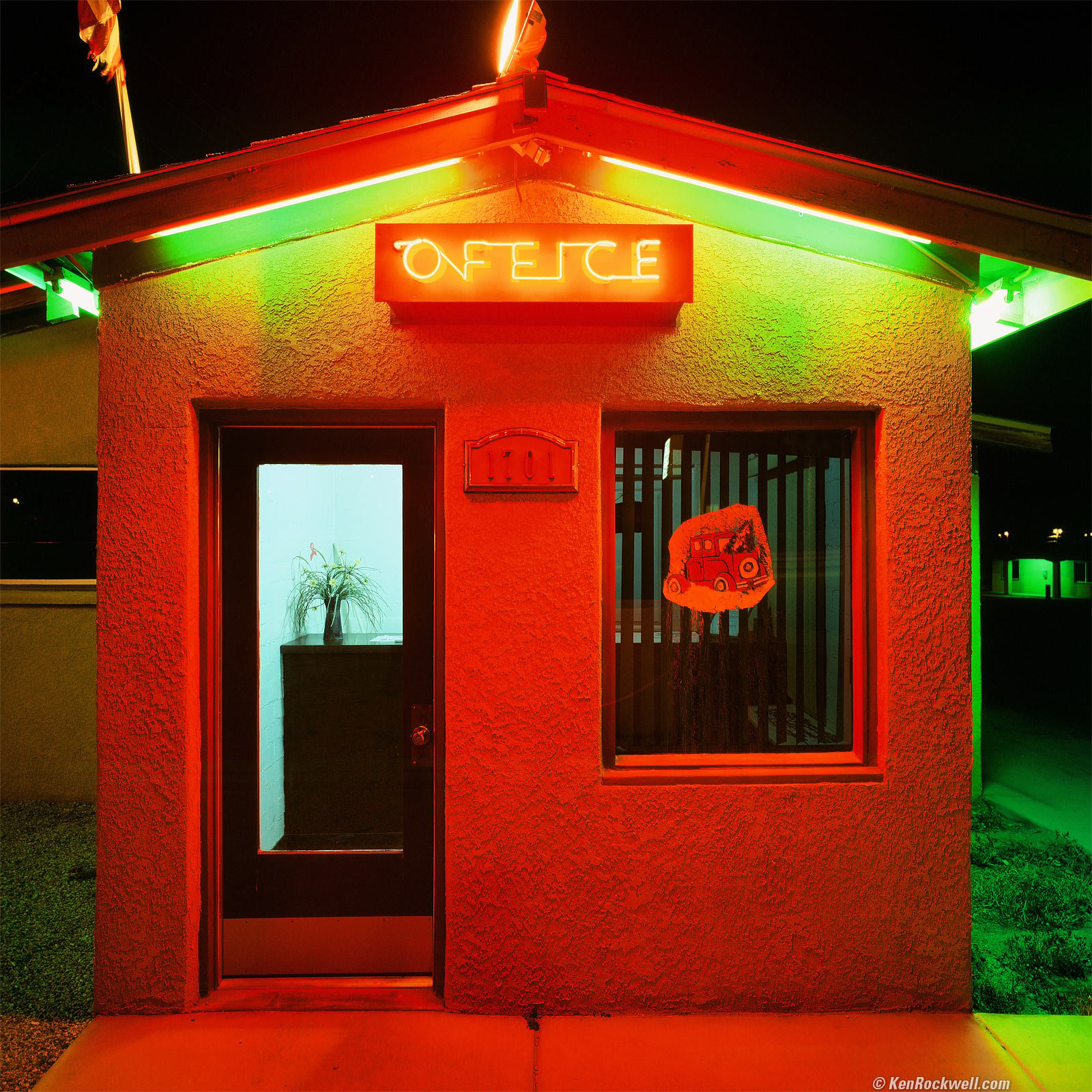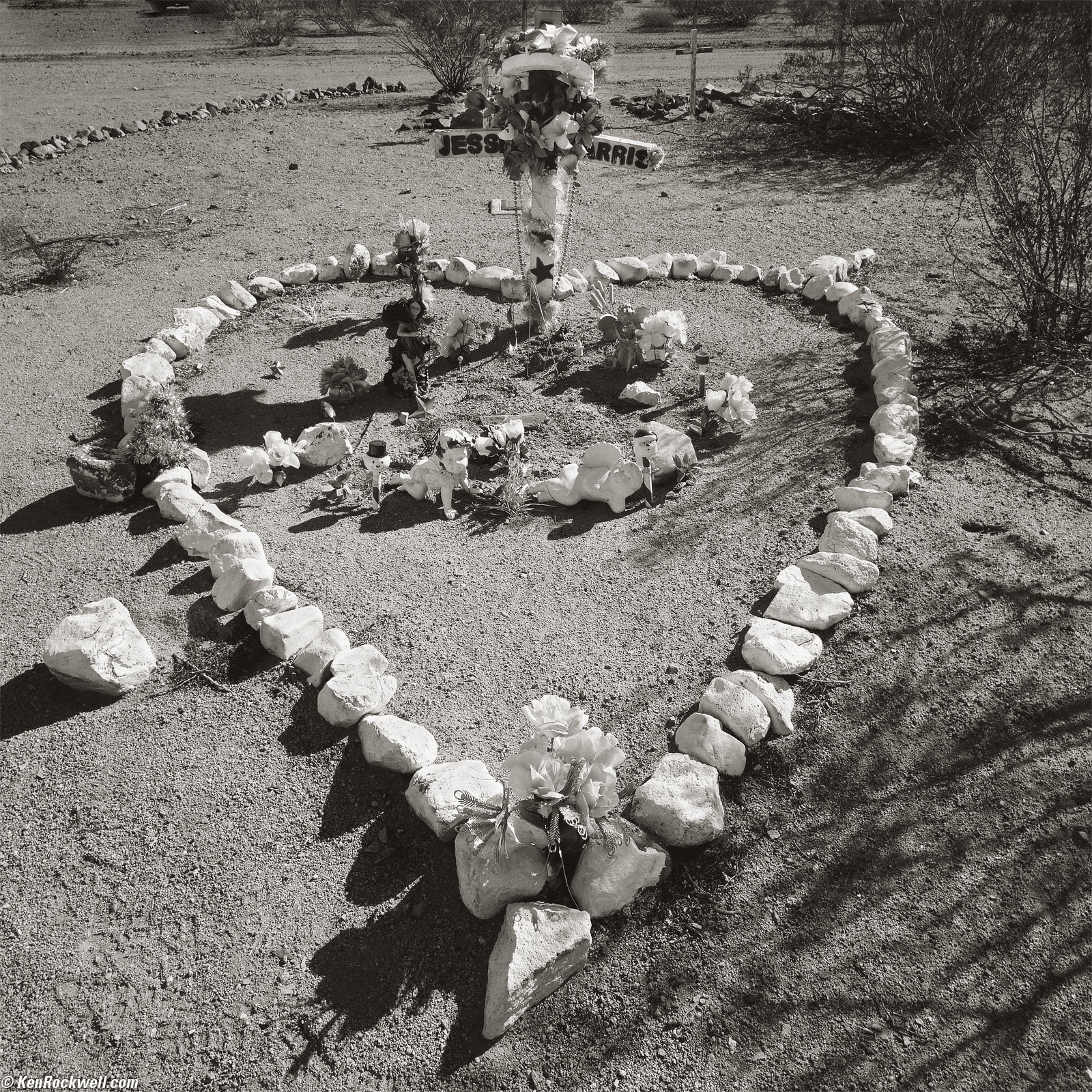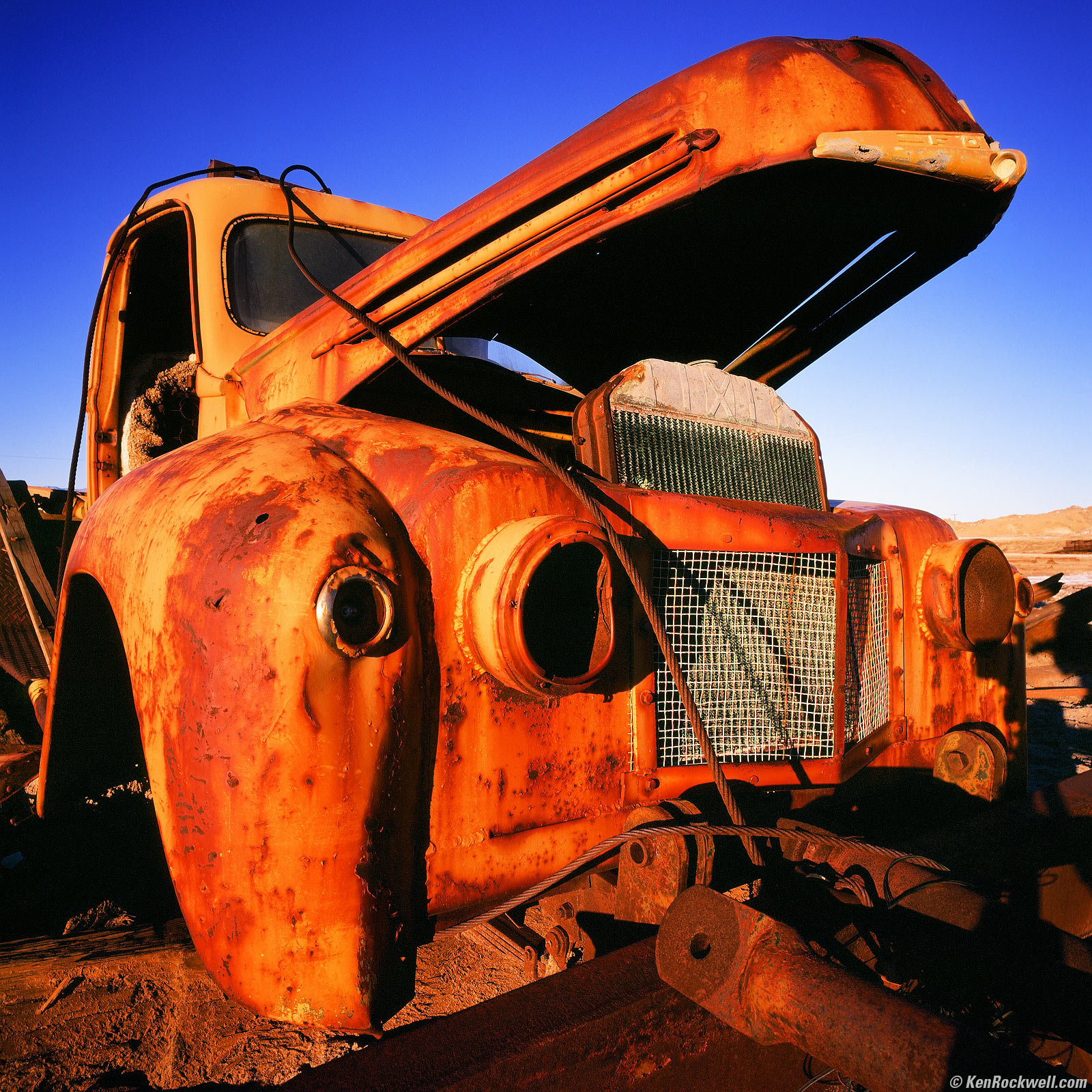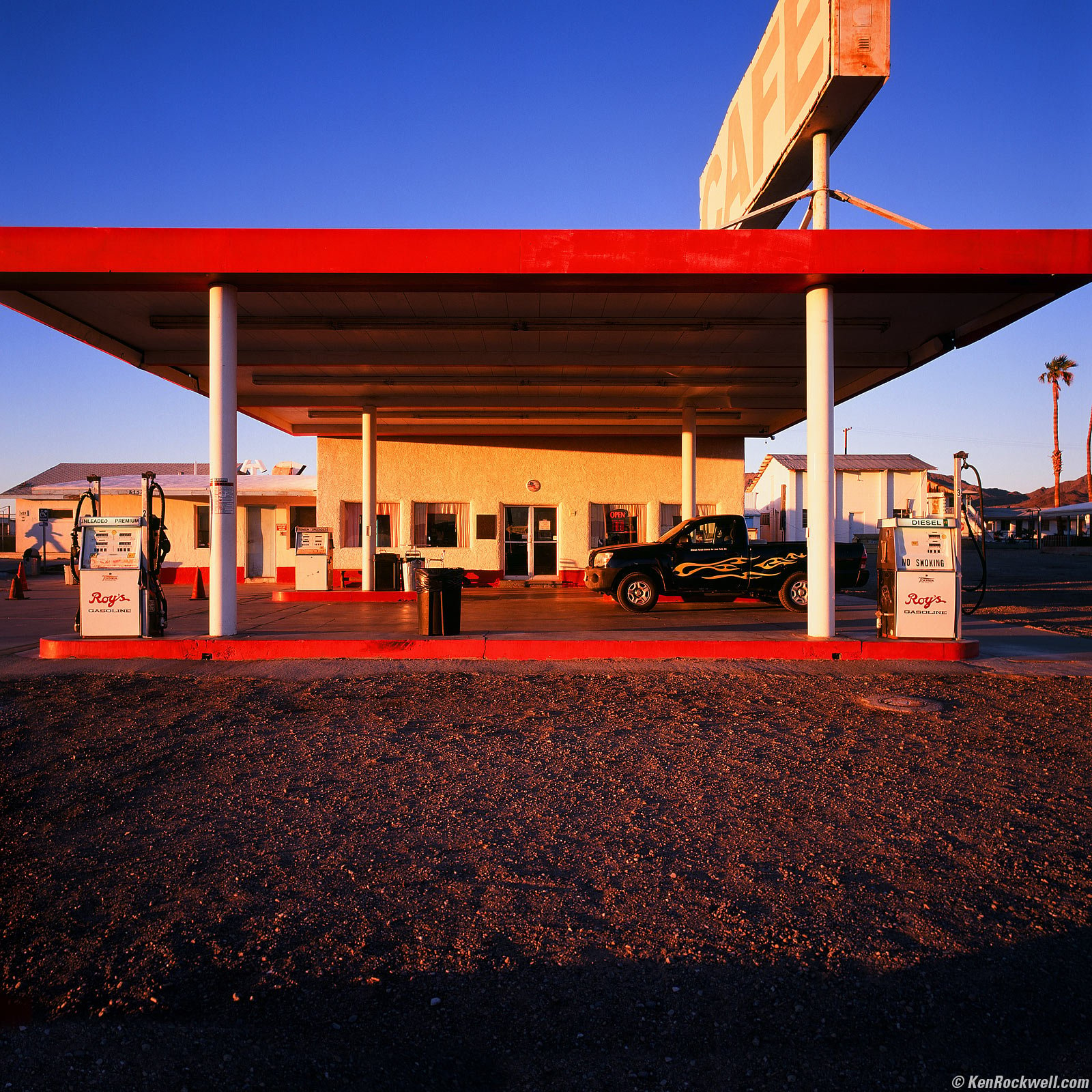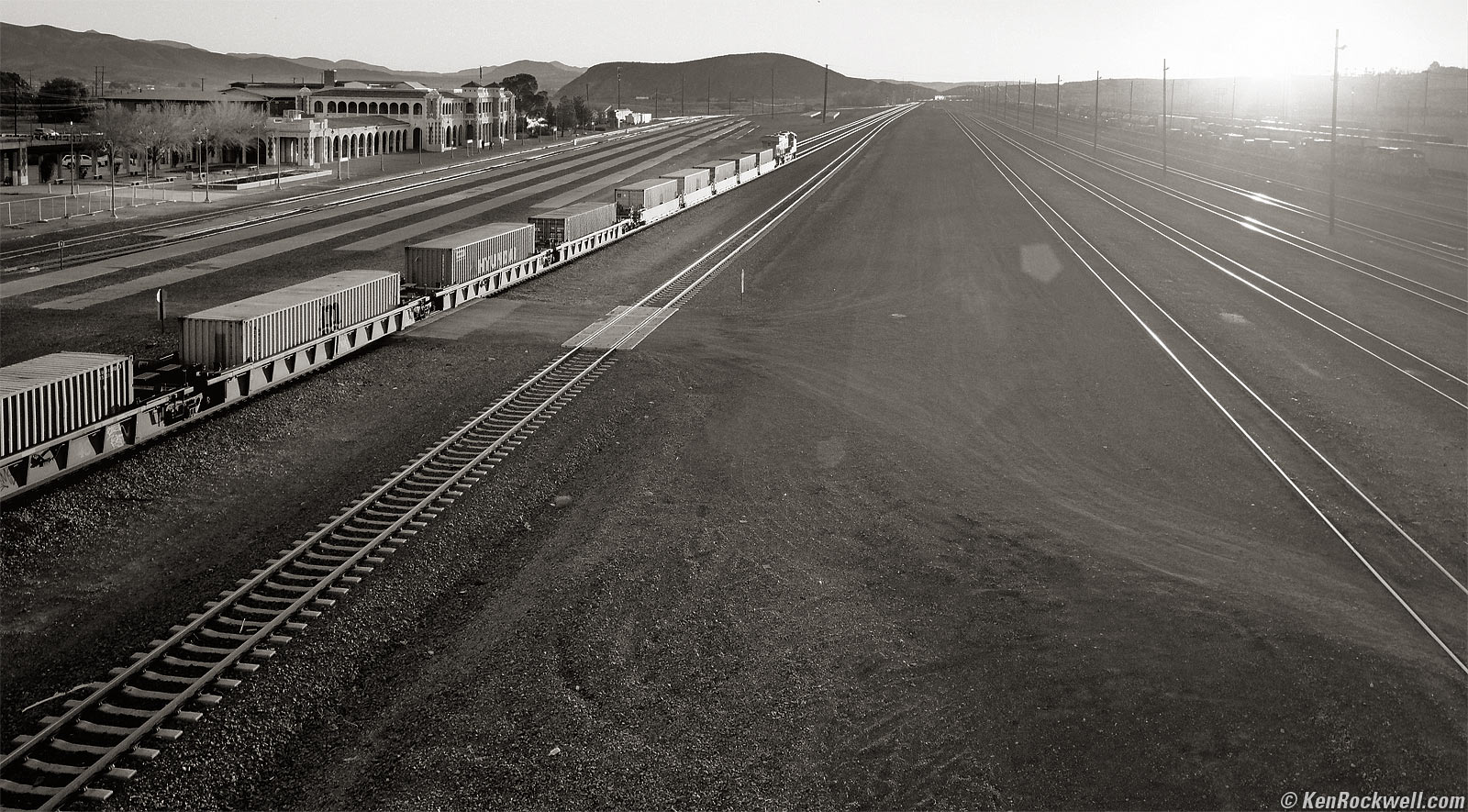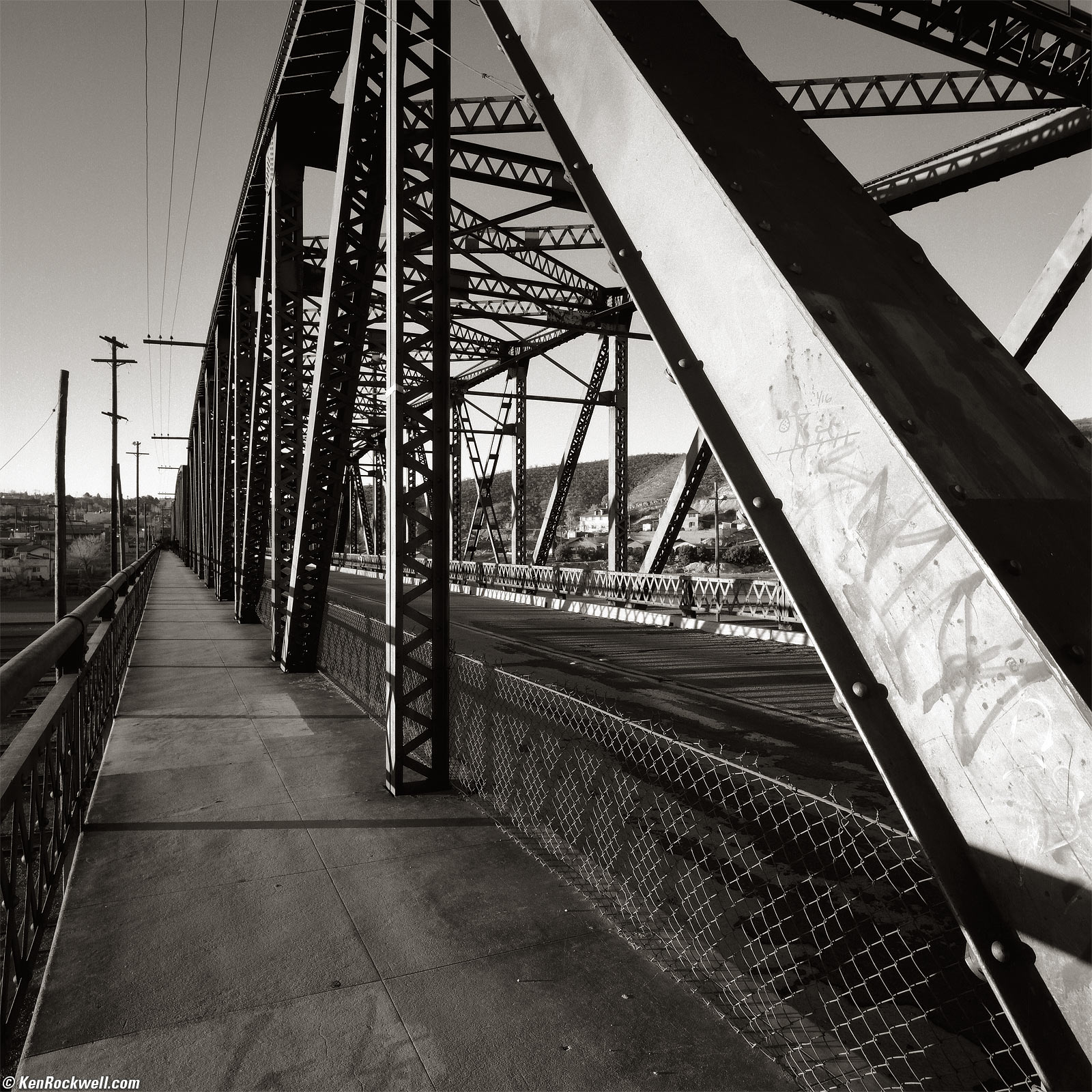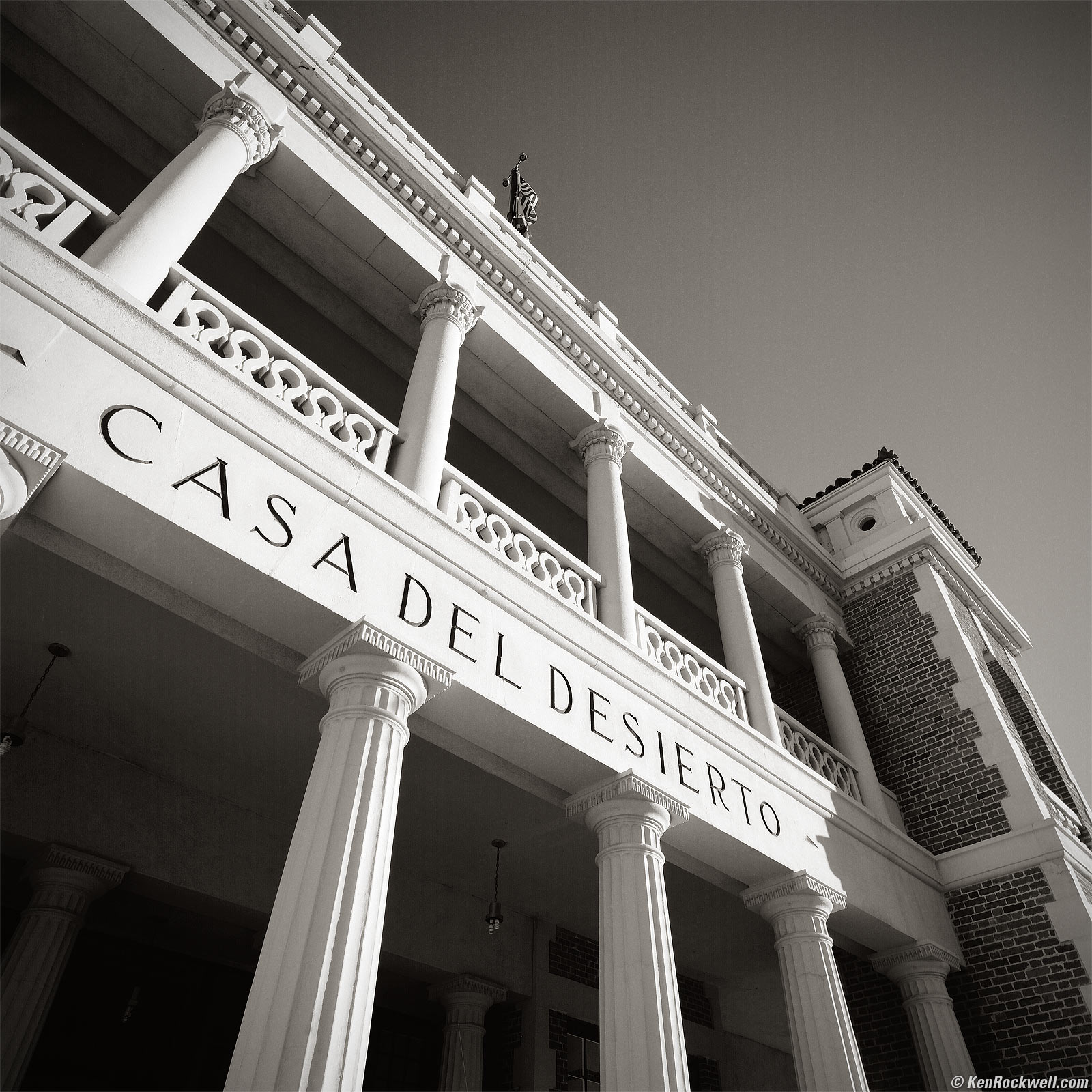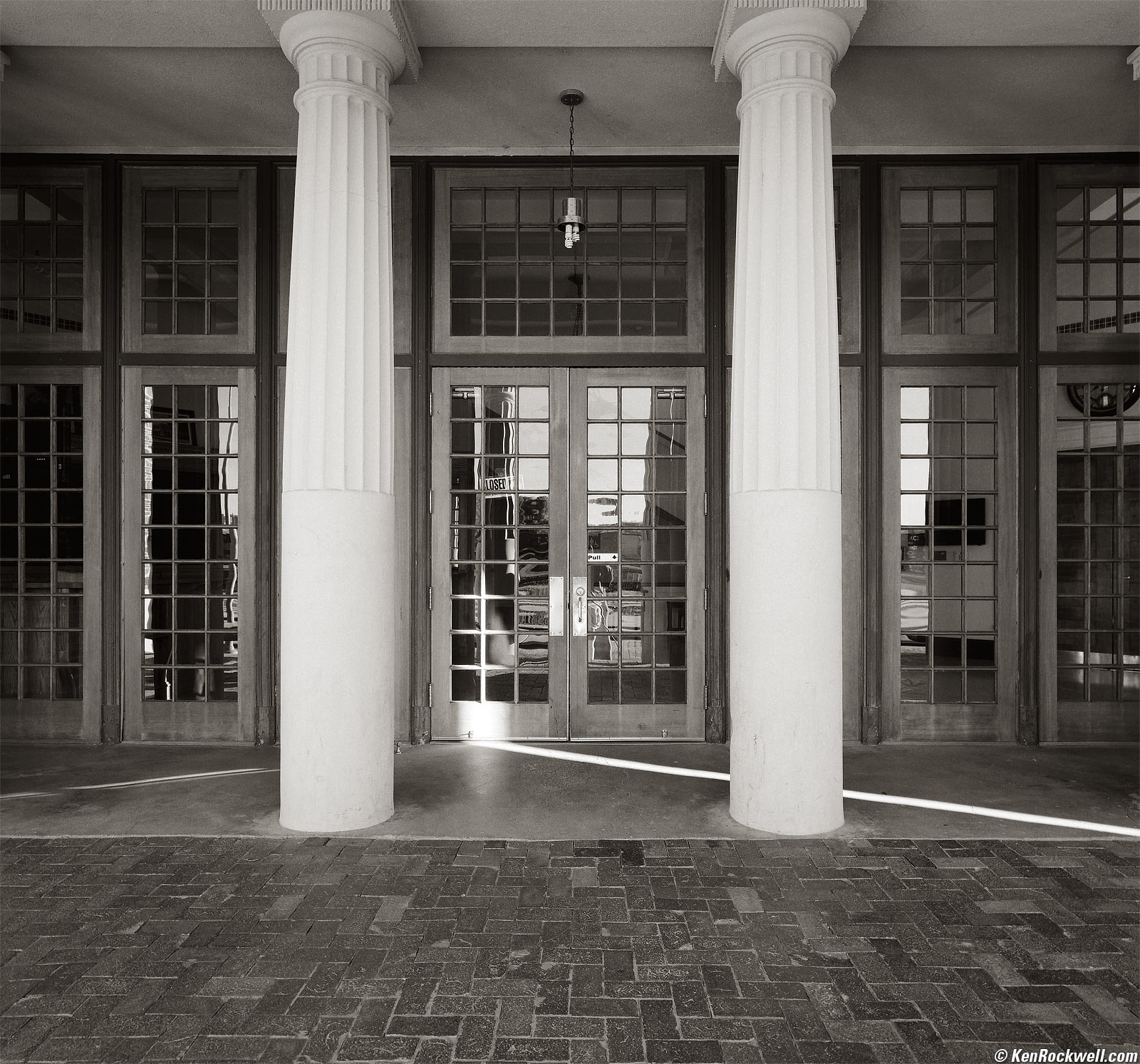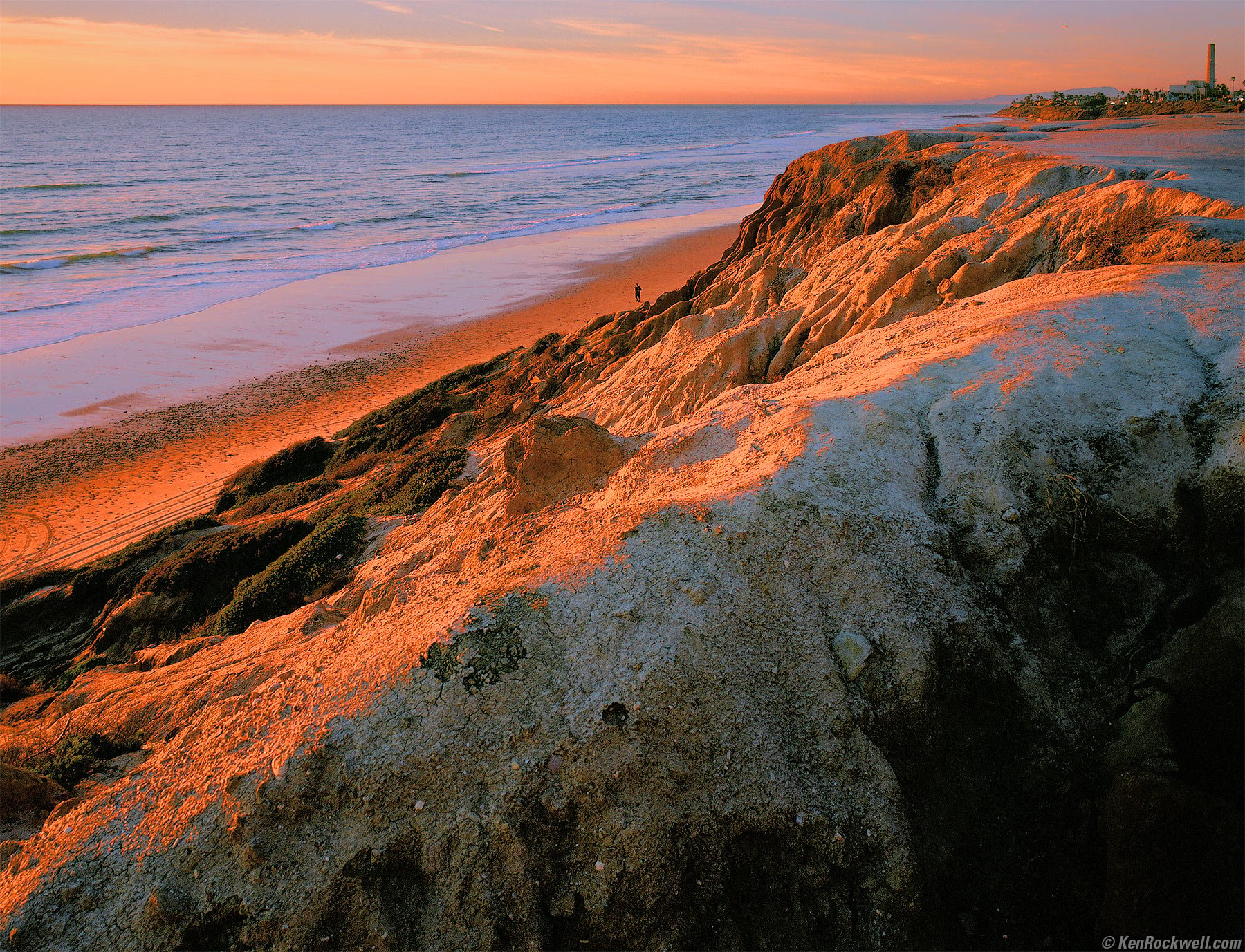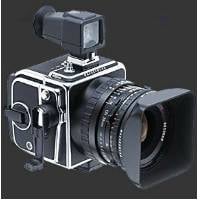HASSELBLAD SWC & 903 SWC
Super Wide Camera (1954-2009)
Specifications Performance Compared
1989 HASSELBLAD 903 SWC with fixed BIOGON T✻ 38mm f/4.5 lens and included finder enlarge (11.5 inches/0.29 meters close focus, Bay 60 filters, 33.2 oz./941 g). With an A12 6×6cm 120 back as shown it weighs about 48 oz./1,360 g and sells for about $3,600 used if you know How to Win at eBay.
This all-content, junk-free website's biggest source of support is when you use those or any of these links to approved sources when you get anything, regardless of the country in which you live. Buy only from the approved sources I use myself for the best prices, service, return policies and selection. Thanks for helping me help you! Ken.
April 2024 Better Pictures HASSELBLAD Zeiss Contax Mamiya LEICA Nikon Canon Sony Fuji all reviews
Why Fixed lenses Take Better Pictures
1961 HASSELBLAD Super Wide C with fixed BIOGON 38mm f/4.5 lens and included finder (11.5 inches/0.29 meters close focus, Series 8 filters, 33.210 oz./941.5 g with series 8 retaining ring and finder). With an A12 6×6cm 120 back as shown it weighs about 48 oz./1,360 g and sells for about $2,250. enlarge. I got mine at this link directly to them at eBay (see How to Win at eBay).
HASSELBLAD Super Wide C, 1961 model. enlarge.
HASSELBLAD 903 SWC and finder (no back). enlarge.
HASSELBLAD 903 SWC, no finder and no back. enlarge.
Sample Images
Top Sample Images Intro History
Specifications Performance Compared
Stairwell at Night, 7:57 P.M. 05 February 2016. 1989 HASSELBLAD 903 SWC with B60 B+W F-DAY mild fluorescent filter, 2 meters focus distance (needed from 4.5' in focus), Fuji Velvia in 1996 HASSELBLAD E24 magazine, f/16 at 1 minute. bigger.
Big Pile of Tires in a Small Room, Route 66, 5:23 P.M. 1989 HASSELBLAD 903 SWC, no filter, 6 foot focus distance , Kodak T-Max 100 in 1993 A12 magazine, f/16 for one minute. More technical details. bigger.
Signs on Ceiling, 4:00 P.M. 1989 HASSELBLAD 903 SWC with B60 Heliopan KR 6 warming filter, 10 feet focus distance, Fuji Velvia in 1996 HASSELBLAD E24 magazine, f/9.5 at 5 seconds (metered EV 4/5 and added ⅓ stop for reciprocity failure, split-toned print). More technical details. bigger.
Bar Stock at Tom's Welding, 4:27 P.M. 1989 HASSELBLAD 903 SWC, no filter, 4.6 foot focus distance, Kodak T-Max 100 in 1993 A12 magazine, iPhone app says EV 4/5, I use f/22 for 40 seconds to add 1 stop for reciprocity failure. More technical details. bigger.
Sleep Inn, Barstow, 6:09 P.M. 1989 HASSELBLAD 903 SWC with Series 8 Tiffen CC40M filter carefully balanced inside front of lens, 9 foot focus distance, Fuji Velvia in 1996 HASSELBLAD E24 magazine, f/16 at 30 seconds (iPhone app read EV 4 through the filter and I added a stop for reciprocity failure). More technical details. bigger.
Square Hole in Stucco Wall at Night, 7:50 P.M. 1989 HASSELBLAD 903 SWC with B60 B+W F-DAY mild fluorescent filter, 4.5 foot focus distance, Fuji Velvia in 1996 HASSELBLAD E24 magazine, f/11 at 25 seconds. More technical details. bigger.
Motel 66 Sign at Night, 8:13 P.M. 1989 HASSELBLAD 903 SWC, no filter, 50' focus distance, Fuji Velvia in 1996 HASSELBLAD E24 magazine, f/11 at 15 seconds. More technical details. bigger.
Red Neon Office Sign at Night, 8:38 P.M. 1989 HASSELBLAD 903 SWC, no filter, 8.5' focus distance, Fuji Velvia in 1996 HASSELBLAD E24 magazine, f/9.5 at 25 seconds. More technical details. bigger.
Stone Heart Around Grave, Daggett, 10:37 A.M. 1989 HASSELBLAD 903 SWC, no filter, 1.2 meter focus distance, Kodak T-Max 100 in 1993 A12 magazine, f/22 at 1/30. More technical details. bigger.
Inside the Bagdad Cafe, Route 66, 12:04 P.M. 1989 HASSELBLAD 903 SWC, no filter, 12 foot focus distance, Kodak T-Max 100 in 1993 A12 magazine, Gossen Luna Pro SBC read EV 8, f/16 at one second. More technical details. bigger.
Old Orange Truck with Hood Up, Route 66, 4:36 P.M. 1989 HASSELBLAD 903 SWC with HASSELBLAD B60 CR 1,5 warming filter, 4.2 foot focus distance (I needed the range from 3 to 9 feet rendered with optimum sharpness), Fuji Velvia in 1996 HASSELBLAD E24 magazine, Gossen Luna Pro SBC reads EV 11/12 at ISO 40, f/19 at 1/8. More technical details, including the viewfinder view through the SWC! bigger.
Old Gas Station at Sunset, Route 66, 5:00 P.M. 1989 HASSELBLAD 903 SWC with HASSELBLAD B60 CR 1,5 warming filter, 60 foot focus distance, Fuji Velvia in 1996 HASSELBLAD E24 magazine, Gossen Luna Pro SBC reads EV 10 at ISO 40, f/8 at 1/15. More technical details. bigger.
Barstow Rail Yard at Dawn. 1989 HASSELBLAD 903 SWC, no filter, Kodak T-Max 100 in 1993 A12 magazine, Gossen Luna Pro SBC at EI 100. More technical details. wider.
Barstow Railroad Bridge at Dawn. 1989 HASSELBLAD 903 SWC, no filter, Kodak T-Max 100 in 1993 A12 magazine, Gossen Luna Pro SBC at EI 100. More technical details. bigger.
Barstow Station Colonnade at Sunrise. 1989 HASSELBLAD 903 SWC, Kodak T-Max 100 in 1993 A12 magazine, Gossen Luna Pro SBC. More technical details. bigger.
No HDR, no problem! With properly-shot film, everything from the disc of the sun and sunstars to the deepest shadows are just there in the first place. Shot on digital the sun would have blown out to a huge, ugly circle instead. Ha!
Barstow Station, Early Morning. 1989 HASSELBLAD 903 SWC, Hoya B60 Orange filter, Kodak T-Max 100 in 1993 HASSELBLAD A12 magazine, Gossen Luna Pro SBC. More technical details. bigger.
Freight Train Whizzing by Barstow Station, Early Morning. 1989 HASSELBLAD 903 SWC, Hoya B60 Orange filter, Kodak T-Max 100 in 1993 HASSELBLAD A12 magazine, Gossen Luna Pro SBC. More technical details. bigger.
This was a slow exposure at f/22, probably about 1/8 of a second, timed for when the train was moving slowly across my frame. Of course with an eighth-second exposure, the crawling train looks like it's going 85 MPH. This is a standard trick in vehicle shots: they drive a car slowly with a camera mounted to it and make a long exposure, and it looks like they're doing a hundred and two and shooting right at the wheel.
Casa del Desierto, Barstow, Early Morning. 1989 HASSELBLAD 903 SWC, Hoya B60 Orange filter, Kodak T-Max 100 in 1993 HASSELBLAD A12 magazine, Gossen Luna Pro SBC. More technical details. bigger.
Columns at the Casa del Desierto, Barstow, Early Morning. 1989 HASSELBLAD 903 SWC, Kodak T-Max 100 in 1993 HASSELBLAD A12 magazine, Gossen Luna Pro SBC. More technical details. bigger.
Sunset at the beach with eroded cliffs, 5PM, 26 January 2016. 1989 HASSELBLAD 903 SWC, B+W B60 CR1,5 filter, focus set to 15 feet, f/8 at 1/15 on original Fuji Velvia (not Velvia 50; this is original Velvia frozen when new and expired 2006-09). NCPS process and scan. bigger.
It's got plenty of depth-of-field for hand-holding at reasonable apertures, and it's easy to hand-hold at slow speeds like 1/15. The real reason you'll want to use a tripod is for precise leveling and composition.
Introduction
Top Sample Images Intro History
Specifications Performance Compared
|
Adorama pays top dollar for your used gear. I buy only from these approved sources. I can't vouch for ads below. |
The HASSELBLAD SWC is an all-manual mechanical camera with a permanently attached super wide-angle lens and a removable viewfinder. It has a 91º angle of view roughly similar to a 21mm lens on a 35mm camera.
All come with a viewfinder. Most are sold with a film magazine, but a film magazine isn't formally part of the camera.
Any of the SWC cameras made from 1954 ~ 2009 works perfectly with any HASSELBLAD magazine made from 1954 ~ 2013 to use either 120, 220 or 70mm film to make 6 × 6 cm (2¼" × 2¼") or smaller images. These magazines are interchangeable so you can swap film type, image size or use a ground-glass back.
Digital backs work on the SWC, but not perfectly because digital backs are not designed to work with its special lens. You may get shifted colors at the sides for exactly the same reason you'll get these same problems on LEICA digital with traditional ultrawides like the 1955 21mm f/4 Super Angulon: film doesn't care, but digital sensors hate it when light hits their sides at shallow angles. SLR lenses avoid this because their retrofocus designs ensure light hits the sensor sides at relatively direct angles.
The SWC has no light meter, no rangefinder and no other focus aids other than an optional ground-glass back. Its depth of field is so deep that all you have to do is guess the distance and set it on the scale.
You set exposure with a hand-held light meter, with an app or simply by experience on its convenient EV scale. All is explained at Usage; it's a very easy camera to shoot.
All versions of the SWC have a level either on the body or in the finder, and all versions allow you to see this level as you're using the finder.
The Super Wide is all about its lens: a satellite-grade ZEISS BIOGON 38mm f/4.5.
The 38mm f/4.5 Biogon lens is exceptional for its complete lack of distortion, lack of mechanical vignetting and high performance even wide-open. These three factors have made it a favorite of aerial and satellite mapping and surveillance, where it can be used wide-open for the shortest exposures. Its lack of distortion is needed for accurate mapping and photogrammetry.
The BIOGON was also favorite for hand-held news reporting back in the days of 4 × 5" cameras; it is both faster than the usual f/5.6 to f/8 wide-angle lenses, and it performs well and has no problems with mechanical light falloff even at f/4.5. News reporters loved the 75mm f/4.5 and 53mm f/4.5 BIOGON for use on sheet film cameras of the 1950s.
History
Top Sample Images Intro History
Specifications Performance Compared
It's been the same camera and the same lens ever since 1954 with only minor changes.
While HASSELBLAD had to do something to keep people buying this same camera for sixty years and therefore trumpeted each of these minor innovations as if they were gifts from God, as you'll read they are only minor. In each case everything about the camera is unchanged except for the minor improvements as noted.
The only significant changes have been automatically cocking the shutter with the film advance as of 1959, T✻ multicoating in 1973, adding Polaroid back compatibility in 1980, changing from Series 8 to B60 filters in 1982, moving the bubble level from the body into the finder in 1986, and dumbing-down the optical design with unleaded glass in 2001.
1952: Biogon lens patented
The Biogon 91º f/4.5 lens is patented by Dr. Ludwig Bertele of Zeiss in 1952. The best known of these is the 75mm f/4.5 for 4x5" press cameras, which has 10 elements.
The 38mm f/4.5 lens used in the SWC is a simplified design with only 8 elements.
The Biogon stands out because it has very little mechanical vignetting, no significant distortion and it's sharp out to the corners even wide-open.
It's designed to be shot wide-open for available light shooting with not much more vignetting than when stopped down.
1954 ~ 1956: Supreme Wide Angle Camera
CAUTION: Priced the same as newer cameras, shutter will probably need service and film and shutter require separate advance and cocking.
The HASSELBLAD Supreme Wide Angle camera was introduced at Photokina 1954 to take advantage of this lens.
You have to cock the shutter separately from advancing the film. The shutter runs in the old scientific speeds of 1-2-5-10 etc., not the geometric 1-2-4-8 scale popular today. The shutter has a black deckeled housing and screwed-on scales that looks like it was designed in the 1930s — because it was.
It has two reversible focus scales, one for feet and one for meters. The focus ring turns 180º and the finder has a small prism and magnifier to let you see the body's bubble level if you look a bit to the left.
These take Series 8 filters held in with a retaining ring.
HASSELBLAD made about 600 of these, serial numbers 1,001 to 1,600.
It listed for $4,200 in 1954, considering inflation in 2019 ($470 at the time).
1956 ~ 1959: Super Wide Camera
CAUTION: Priced the same as newer cameras, shutter will probably need service and film and shutter require separate advance and cocking.
Except for the name change from "Supreme" to "Super" and the focus now turning 320,º this is the same camera as before.
HASSELBLAD made about 1,400 of these from serial number 1,600 to 2,999.
1959 ~ 1969: Super Wide C
HASSELBLAD Super Wide C. enlarge.
CAUTION: Compur shutter may have scratched inner lens elements, and the shutter will probably need service from age and lack of use.
The Super Wide C adds combined film & shutter cocking with a more familiar "C" style silver lens barrel.
These "C" cameras have fluted metal focus rings.
All bodies and lenses are chrome. (Bodies of course have black leather trim.)
The earliest samples, at least until 1961, have a green flash sync lever, while newer ones since 1964 have a thinner chrome sync lever. All versions have a thin sync lock lever.
Shutter speeds and exposure values were engraved until at least 1961, but merely printed since 1967.
These have sold for about $1,250 used in 2016 and 2019 and about $2,250 in 2024, if you know How to Win at eBay.
1969 ~ 1973: Super Wide C
CAUTION: Compur shutter may have scratched inner lens elements, and the shutter will probably need service from age and lack of use.
HASSELBLAD added a tiny rubber bumper on the viewfinder eyepiece.
All bodies are chrome.
Lenses are chrome, with black lenses optional.
These "C" cameras have fluted metal focus rings.
1973 ~ 1980 Super Wide C T✻
CAUTION: Compur shutter may have scratched inner lens elements, and the shutter will probably need service from age and lack of use.
Bodies now come in black as well as chrome, and Zeiss added T✻ multicoating.
HASSELBLAD made only a few chrome T✻ lenses in 1973, and then switched to making only black lenses. It is unusual to see a chrome T✻ SWC lens.
Since black lenses have been optional since 1969 and T✻ multicoating didn't come out until 1973, you will see plenty of black-lens SWCs that are not T✻.
These "C" cameras have fluted metal focus rings.
1969-1980 SWC serial numbers 3000 ~ 15471, then 141001 and up.
1979 ~ 1982: SWC/M
CAUTION: Compur shutter may have scratched inner lens elements, and the shutter will probably need service from age and lack of use.
The SWC was modified to fit the large Polaroid 100 back by raising the finder, lowering the tripod foot and adding a ratchet to the film advance crank.
This modification is the "M" in SWC/M.
HASSELBLAD also was able to modify existing SWCs into SWC/Ms if you sent one to them.
These "C" cameras have fluted metal focus rings.
All have black lenses and the bodies came in chrome or black.
Serial numbers start around UE 141800.
1982 ~ 1985: SWC/M with CF lens
RECOMMENDED: First model with the new Prontor shutter; you probably won't need service and there's no problem with internal elements getting scratched.
HASSELBLAD introduced the new Prontor shutters for their lenses at Photokina 1982.
The SWC now has a CF style lens barrel, meaning a Prontor shutter and taking B60 filters. The body is unchanged.
These Prontor-shuttered CF lenses have rubberized focus rings, the footage scale marked in orange and have an internal bayonet for B60 (Bayonet 60mm) filters.
The Prontor shutters still have a red line over 1, 2 and 4, which means nothing on the SWC.
All lens markings are now printed.
All have black lenses and the bodies came in chrome or black.
1986 ~ 1988: SWC/M with new finder
RECOMMENDED: This SWC/M is as good as the 903 SWC and usually sells for a little less.
In 1986 HASSELBLAD switched to a new finder with a built-in bubble level.
The bubble level was therefore removed from the bodies.
All have black lenses and the bodies came in chrome or black.
1989 ~ 2001: 903 SWC
HASSELBLAD 903 SWC: note bubble level atop finder.
RECOMMENDED: Has the good lens, new enough that it's unlikely to need any kind of service, but expect to pay more than for an SWC/M.
The 903 SWC adds "Palpas internal coating," claimed to control internal reflections better. That's another name for blacker paint, and seeing how the lens is so close to the film that light never gets to bounce off the inside of the camera anyway, not a big deal.
No one even knows what Palpas is; it doesn't really exist.
All have black lenses and the bodies came in chrome or black.
These sold for about $3,000 used in 2016 and 2017, about $3,500 used in August 2019, and about $3,600 used in 2024 if you know How to Win at eBay.
These have the same CF lens as the 1982 version.
While it's the same camera and lens and factory, the fall of the Berlin Wall and reunification of Germany in 1989-1991 changed the lens markings from "Made in West Germany" to "Made in Germany." All this does is roughly date the camera, but it's easier to read the date code directly from the serial number.
28 August 2001 ~ 2009: 905 SWC
HASSELBLAD 905 SWC: note blocky rubber grips on focus and aperture rings.
AVOID: Has a slightly poorer lens design, a plastic filter mount, and costs more than any of the others. It's a great camera, but sells used for way above any of the better earlier cameras.
The first downgrade in the history of the SWC, the 905 SWC replaced the original Biogon with a watered-down version using only unleaded glass. The leaded glass of the original Biogon was removed to aid the health of those who working around the lens' grinding and polishing stages.
This new lens isn't quite as good as the original, but close enough.
The lens is now also a CFi version, meaning that the feet and meter scales are the same color to make them confusing.
The CFi lenses downgraded from metal to a plastic filter mount, enthusiastically called "Makrolon" by HASSELBLAD's marketing people.
HASSELBLAD for the first time threw in a free lens shade to ease the pain. It sold for $8,000 new when considering inflation in 2016 ($6,000 at the time).
All have black lenses and the bodies came in chrome or black.
Specifications
Top Sample Images Intro History
Specifications Performance Compared
Lens
ZEISS BIOGON 38mm f/4.5.
8 elements in 5 groups
38.6mm actual design focal length.
194 ~ 1973: Single coated.
1973 ~ 2009: T✻ multicoated.
Made in Germany.
Filter Size
1954 ~ 1982
Series 8 with retaining ring.
1982 ~ 2009
Bayonet 60.
Image Size
55.0 × 56.0 millimeters H × V (78.49mm diagonal) actual measured image size on 1993 A12 magazine.
Angle of View
91º diagonal.
72º horizontal and vertical.
Diaphragm
5 straight blades.
Half-stop clicks to f/22.
Shutter
1/500 ~ 1 second plus Bulb (on shutter ring) and Time (around shutter button).
Flash Sync
X sync at all speeds up to 1/500.
Compur shutter versions (1954 ~ 1982) also have an M sync setting for M flashbulbs.
CF versions (Prontor shutter, 1982 ~ 2009) have only X sync.
Self Timer
Compur shutter versions (1954 ~ 1982) have a V position for a 9-second self timer.CF versions (Prontor shutter, 1982 ~ 2009) have no self timer.
Focus
Manual scale focus.
Focus Rotation (infinity ~ closest setting)
1954 ~ 1956: 180º
1956 ~ 1959: 320º
1959 ~ 1982: 270º (C lenses)
1982 ~ 2009: 120º (CF lenses).
Close Focus
12'/0.3m, marked.
11.5'/0.29 meters actual; the focus ring turns closer than 12'/0.3 meters.
Hood
1954 ~ 1982
Round metal screw-in; also doubles as a Series 8 filter holder.
1982 ~ 2009
Square bayonet 60.
Metal bayonet mount with plastic hood.
Same hood as for 50mm and 60mm lenses, marked "38-60mm."
Camera Body
One piece cast aluminum alloy.
Interchangeable film backs and ground glass adapters.
Works with digital backs, but digital backs don't work well with the BIOGON lens.
Finders
Original (1954 ~ 1986)
All metal housing.
One small circle in middle of otherwise clear field of view.
Prism with magnifier on left side to let you see the camera-body level.
Small rubber bumper added to eyepiece 1969 ~ 1986.
New (1986 ~ 2009, Nr. 52036)
Plastic housing.
Rubber eyecup.
Locking shoe.
Built-in level visible from top of camera or looking through finder.
0.23x magnification.
Annoying corners for 16S back (41.5 x 41.5mm format ) always in finder. They also mark the view for a 50mm lens.
One small circle in middle of view.
Size
903 SWC (1989)
Optical Center
55mm (2.17") above tripod mounting face.
Body Only
113mm (4.49") tall.
112mm (4.41") wide.
126mm from lens to back of tripod plate.
With finder
153mm (6.00") tall.
112mm (4.41") wide.
134mm deep from front of lens to finder eyecup.
With finder and A12 magazine
153mm (6.00") tall.
112mm (4.41") wide.
147mm (5.71") from front of lens to back of magazine.
Weights
SWC (1961)
Complete camera, finder, film and back: 48 oz. (1360 g) with finder, filter retaining ring, A12 magazine and film.
Camera & finder only: 33.210 oz. (941.5 g) with series 8 retaining ring but no back.
Camera only: 30.115 oz. (853.75 g) with series 8 retaining ring but no finder and no back.
Finder only: 3.095 oz. (87.8 g).
903 SWC (1989)
Measured
48 oz. (1360 g) with finder, A12 magazine and film.
33.205 oz. (941.4 g) with finder but no back.
The 51063 rear protective cover weighs an additional 0.700 oz. (19.9 g).
A loaded A12 magazine weighs about 15 oz (425g).
Finder alone weighs 2.270 oz. (64.4g).
903SWC alone weighs 30.940 oz. (871.1g).
903SWC, finder and rear cover weighs 33.915 oz. (961.4g).
Rated
33.2 oz. (940g) with finder but no back.
48.2 oz. (1,365 g) with finder and magazine (no film).
Quality
Lens and finder made in Germany
Camera body and backs made in Sweden.
Included (903 SWC)
Body, chrome (Nr. 10052) or black (Nr. 10201).
Finder (Nr. 52036).
Neck strap.
Lens cover.
Rear cover.
(Film magazine not included when new.)
Price, U. S. A. specifications top
April 2024
903 SWC: About $3,600 used if you know How to Win at eBay.
SWC & SWC/M: About $2,500 used if you know How to Win at eBay.
1960s Chrome SWC: About $2,200 used if you know How to Win at eBay.
September 2019
903 SWC: About $3,500 used if you know How to Win at eBay.
1960s Chrome SWC: About $1,250 used if you know How to Win at eBay.
Performance
Top Sample Images Intro History
Specifications Performance Compared
Overall
An SWC of any age is ultrasharp and has no distortion. Presuming you have perfect focus, it's ultrasharp corner-to-corner even wide open.
It has the same mild light falloff at every aperture, typical for true non-retrofocus ultrawide lenses.
Its 5-bladed diaphragm makes 10-pointed sunstars on brilliant points of light.
Mechanics
The earliest versions through the mid 1960s are superb, with zero plastic and all markings for everything engraved as seen on the 1961 sample shown at the top.
As of the mid 1960s the shutter speeds were downgraded to simple printing.
As of the CF versions of 1982, all markings are merely printed, but time has shown that it's unusual for this to wear off.
Focus
The cameras from 1954 ~ 1982 have focus scales with precise tick marks.
For a camera whose performance depends entirely on your ability to set precise focus distances, the newer 1982 ~ 2009 cameras have a surprisingly cavalier focus scale.
Shutter
903 SWC
My 903 SWC shutter is within a third of a stop at every speed. Skipping 1/500 which is 1/3 of a stop slow, it's within one-seventh of a stop at every speed, and if we skip 1/250, it's within one tenth of a stop at every other speed.
Half of the speeds are within one-fourtieth of a stop!
This is superb for a mechanical shutter:
Marked |
Actual |
Actual |
Error |
1 |
987 ms |
1/1.01 |
0.02 stops fast |
2 |
509 ms |
1/1.96 |
0.025 stops slow |
4 |
236 ms |
1/4.2 |
0.08 stops fast |
8 |
118 ms |
1/8.5 |
0.03 stops fast |
15 |
58 ms |
1/17 |
0.10 stops fast |
30 |
31.7 ms |
1/31.5 |
0.02 stops slow |
60 |
15.9 ms |
1/62.9 |
0.025 stops slow |
125 |
7.4 ms |
1/135 |
0.08 stops fast |
250 |
4.3 ms |
1/233 |
0.14 stops slow |
500 |
2.4 ms |
1/417 |
0.30 stops slow |
These are measured wide-open, 21 January 2016.
SWC (1961)
My SWC (1961) shutter is slow at the highest speeds, and sticks sometimes at the slow speeds. It needs work; also each of these speeds tends to vary a little from frame to frame.
Marked |
Actual |
Actual |
Error |
1 |
950 ms |
1/1.05 |
0.07 stops fast |
2 |
480 ms |
1/2.08 |
0.06 stops fast |
4 |
250 ms |
1/4 |
± 0.00 stops |
8 |
117 ms |
1/8.55 |
0.10 stops fast |
15 |
63 ms |
1/15.9 |
0.01 stops slow |
30 |
34 ms |
1/29.4 |
0.12 stops slow |
60 |
18.6 ms |
1/57.8 |
0.25 stops slow |
125 |
10.0 ms |
1/100 |
0.36 stops slow |
250 |
5.6 ms |
1/179 |
0.52 stops slow |
500 |
4.1 ms |
1/243 |
1.07 stops slow |
These are measured wide-open, 03 February 2016.
While the 1 second speed was OK when it first arrived, the next day and/or if I actually took it outside to shoot at 55º F, it became sticky and slower — regardless of the seller's claim that it had just been serviced. Not all service facilities are good!
Compared
Top Sample Images Intro History
Specifications Performance Compared
Compared to the Mamiya 7 and 43mm lens the SWC is primitive, which makes sense for a camera designed 50 years ago. The Zeiss Biogon for the SWC is an abbreviated 8 element design from the original 10 element design. The Mamiya 43mm lens appears to be a direct copy of the original 10 element Biogon design. The word Biogon is a trademark and may not be used by Mamiya, however the patents on the design itself have long since expired.
This is funny: Mamiya makes the full, original 10 element version which is spectacular, and the current HASSELBLAD model 905SWC is a dumbed-down 8 element version.
One focuses the SWC by guessing at the distance and setting it on the scale; the Mamiyas have precision rangefinders.
Yes, a new SWC is $6,000 and well made, but no, it is not better optically than the Mamiyas. The advantage to the SWC is the interchangeable backs and better mechanics, otherwise, the Mamiyas are the way to go.
Usage
Top Sample Images Intro History
Specifications Performance Compared
Metering
To meter, set the EV on the lens by experience, or use a hand-held light meter, or use an app. If you use an app, I use the pro version.
Focussing
To focus, guess, use a tape measure or use an external rangefinder.
I usually use my outstretched arms to measure in six-foot increments.
Set the distance on the focus scale.
It's not that critical.
Depth of Field
To calculate the aperture that will give optimum sharpness when you need depth-of-field and don't want diffraction to soften the image, put a new scale over the computer display (C lenses) or depth-of-field scale (CF lenses) and use these half distances (see here for details of how to use these):
Focal length = 38.6 mm (actual design value)
f/ |
feet |
meters |
Aperture on scale |
Aperture on computer |
4.5 |
182 |
55.5 |
||
5.6 |
116 |
35.2 |
||
8 |
57.8 |
17.6 |
(f/1.4) |
|
9.5 |
40.8 |
12.4 |
(f/2.2) |
|
11 |
28.9 |
8.81 |
(f/2.8) |
|
13.5 |
20.4 |
6.21 |
(f/4) |
(f/4) |
16 |
14.4 |
4.4037 |
f/5.6 |
f/5.6 |
19 |
10.2 |
3.11 |
f/8 |
f/8 |
22 |
7.22 |
2.2 |
f/11 |
f/11 |
(how to use this or print scale)
Computer values:
f/ |
scale |
Computer feet |
4.5 |
19'/5.9m |
17 |
5.6 |
16'/4.8m |
15 |
6.7 |
12 |
|
8 |
10.5'/3.1m |
10 |
9.5 |
8.7 |
|
11 |
8'/2.4m |
7.2 |
13 |
6.1 |
|
16 |
5.2'/1.6m |
5.2 |
19 |
4.4 |
|
22 |
4.05'/1.205m |
3.92 |
Filters
1954 ~ 1981: Series 8
These take Series 8 (a.k.a. Series VIII or Series 63mm) filters.
Series 8 filters are unthreaded filter discs which are held in with a separate threaded retaining ring. If you didn't get this ring with your camera, you got ripped off and will need to find one to use filters.
If you're missing your retaining ring, it looks like a 67mm thread, but 67mm filters won't work because the thread pitch is different. Even if you could thread-on a filter, it wound vignette; the Series 8 filters drop inside the lens.
Series 8 filters are easy to find at B&H, at Adorama and used at eBay
1982 ~2013: Bayonet 60
These filters are a little hard to find and usually expensive, but they are easy to use and are the same as almost all other HASSELBLAD lenses made from 1982 from 50mm through 250mm.
You can find B60 filters at B&H, at Adorama and used at eBay.
You also can use reasonably thin 67mm filters with a B60 to 67mm adapter ring.
Recommendations
Top Sample Images Intro History
Specifications Performance Compared
Any of the Super Wide cameras in good shape will take exactly the same pictures. The problem is finding an older one in good shape. Just like buying a used car, we pay more for newer models mostly because they are more likely to be in better shape.
A $1,250 chrome SWC from the 1960s will take the same sharp, contrasty and colorful images as the newest versions from the 2000s — but only if it's still in great shape.
The real reason to pay more for a newer model is simply to get one more likely to work. If you plan to send it out to an expert repairman like Gus Lazzari, you may as well get one of the oldest models.
T✻ multicoating isn't all that great on the SWC, so I wouldn't go out of my way looking or paying for it. Most of the T✻ SWC lenses I've seen still appear as if the front and rear surfaces are barely coated. While the non-T✻ (single-coated) lenses seem almost as if they aren't coated at all, the T✻ lenses aren't coated that well either. Look into a lens, and you'll see many reflections and lens elements. A well coated lens, like any Chinese-made DSLR kit lens today, looks almost completely black as you look into it; you're not supposed to see any of the elements inside as you can on the T✻ SWC lenses.
What does matter is condition. While a 1960s chrome SWC is a joy to behold, even if you can find one without any lens-element internal scratching explained below, it will probably need its shutter serviced, which can lead to lens problems if not done perfectly. The beautiful 1961 sample shown at the top that I bought in 2016 looked and felt great and was supposed to have just been serviced, but its slow and fast shutter speeds were still off — and its glass was scratched internally.
I'd pass on the first 1950s versions that require separate film advance and shutter cocking. Leave these for the collectors since they sell for as much as newer models.
The good news is that even 50-year old SWCs from the 1960s usually have clean glass; the lubricants don't condense back on the internal elements so I've not seen any that need internal cleaning. That's good, because the BIOGON's performance is notoriously sensitive to the distance between front and rear groups being aligned to within microns, so if your repairman isn't careful and doesn't put it back together exactly right, you'll never have the sharpness you used to have.
The bad news is that all SWCs with Compur shutters (the old style with fluted metal focus rings) have a little turned-up edge on one shutter blade. There is very little clearance between the internal elements and these shutter blades, so many of these have slightly scratched the glass internally. Many of the samples you'll see for sale of the Compur shutter cameras will have some scratching inside the lens from the shutter blade, which can lead to a light smear on your images if they include brilliant points of light, like the sun. It's usually only a problem if you feature the sun or bright lights in your images, and can help get you a big discount. It's hard to see this marring; sellers certainly don't go out of their way looking for it.
An advantage of the older Compur shutters is that they have a self-timer and are much quieter.
The newer Prontor shutter of the CF-style lenses (B60 filter size since 1982) is completely different. Its shutter blades have no turned-up edges, so there is no problem with the blade scratching the lens elements. These are also new enough that they probably still work great without needing service — but they have a much notchier trigger pull and are noisier.
B60 filters are much easier to use than the older Series 8 filters and retaining rings. It's easy to get Series 8 filters, but more of a pain to swap them while shooting. I prefer the B60 filters. B60 to 67mm adapter rings usually work well with regular or thin 67mm filters, while you can't really adapt anything else to the old Series 8 lenses due to vignetting.
In 1999 I bought one from 1968, serial # TRW8326 with lens serial # 4241589. It was not as sharp as my Mamiya 6 50mm lens, or the 43mm lens on my Mamiya 7, and its back had light leaks. It's tough to get an old camera that works well. For all I know this sample had been worked on by someone who didn't put it back together properly; alignment is critical and ZEISS warns not to let anyone else mess with it.
A 903 SWC or newer should work great as-is with no service. The early 1989 sample I purchased is swell and has a super accurate shutter.
The on-body level and finder with magnifying prism of the old camera is more accurate and precise than the new cameras with the level in the finder, but the newer finder is much faster to use since you can see the level at the same time as composing. I prefer the older finder for use on a tripod, and the newer one for hand-holding.
The old finder has just a big square opening, while the new finder with the internal level has an extra frame inside it for use with the 16S (41.5 x 41.5mm cropped-frame) back. Unless you're shooting with a smaller format back, these irrelevant frame corners get in the way.
The lens of the newest 905 SWC is inferior, but not by much. I doubt I'd see any difference (I haven't tried it), but considering that the 905 SWC still sells for more than the older models with better lenses and has a plastic front filter mount, I'd pass on the 905 SWC. The 903 SWC is the newest version that still uses the good original lens; the newer 905 SWC has the downgraded lens.
Unless you're a gambler, the models to get are any with the good (leaded-glass and metal filter mount) lens and Prontor CF shutter. These are any that take B60 filters with a metal filter bayonet. Look for any made from 1982 (the first CF SWC/M) through the 903 SWC made through 2001. I'd avoid the older ones from 1954 ~ 1982 that take Series 8 filters because they probably have scratched internal elements and sticky shutters. If you can find a great early version, I'd get it — but I've never seen a perfect one. I'd also avoid the newest 905 SWC for its slightly inferior lens and plastic filter mount, and mostly because it costs more than any of the others because its newer.
Tiffen Bay 60 UV
Where to Get Yours
I got mine at at this link to them at eBay. See How to Win at eBay to get yours.
This all-content, junk-free website's biggest source of support is when you use those or any of these links to approved sources when you get anything, regardless of the country in which you live. I use the stores I do because they ship from secure remote warehouses where no one gets to touch your new camera before you do. Buy only from the approved sources I use myself for the best prices, service, return policies and selection.
Thanks for helping me help you!
Ken Rockwell
More Information
Top Sample Images Intro History
Specifications Performance Compared
Towards the beginning of episode 10, season 2 of "The Odd Couple," titled "Win One for Felix," Felix mentions and shows his "new $900 camera," which is a brand-new chrome SWC with its box. This episode first aired on 03 December 1971.
© Ken Rockwell. All rights reserved. Tous droits réservés. Alle Rechte vorbehalten. Alla rättigheter reserverade. Eftertryck förbjudes.
Help Me Help You
I support my growing family through this website, as crazy as it might seem.
The biggest help is when you use any of these links when you get anything. It costs you nothing, and is this site's, and thus my family's, biggest source of support. eBay is always a gamble, but all the other places always have the best prices and service, which is why I've used them since before this website existed. I recommend them all personally.
If you find this page as helpful as a book you might have had to buy or a workshop you may have had to take, feel free to help me continue helping everyone.
If you've gotten your gear through one of my links or helped otherwise, you're family. It's great people like you who allow me to keep adding to this site full-time. Thanks!
If you haven't helped yet, please do, and consider helping me with a gift of $5.00.
As this page is copyrighted and formally registered, it is unlawful to make copies, especially in the form of printouts for personal use. If you wish to make a printout for personal use, you are granted one-time permission only if you PayPal me $5.00 per printout or part thereof. Thank you!
Thanks for reading!
Mr. & Mrs. Ken Rockwell, Ryan and Katie.
